#hopefully i scaled my images correctly this time
Text
Yu-Gi-Oh! Duel Monsters GX Episodes 102-104 Subbed (Finalized) - Fixes/Edits Breakdown (Part 2)
Since it’s 2023 and Tumblr still has a dumb link limit in posts, I had to break up my Fixes/Edits Breakdown post supplementing my 102-104 Release Post with my usual animation fix/edit breakdown into two parts, since I wanted to still link to the images to give the interested a visual element (hopefully you're enjoying that 🙃). Details for 104's fixes below the cut! (Part 1 for 102-103 here.)
Fixes/Edits! (104)
During 104's recap of Judai's last turn, I re-applied my fixes to the blank Neos spot and the Neos Glow Moss that Judai draws.
During the new bit of footage after the 103 recap before the OP, I re-applied my fix to Judai's head moving a frame early that I did for 103's 104 preview.
Later on, after Judai uses HERO Flash to bring Neos back to the field, he tells a mocking Saiou that HERO Flash lets him attack directly--Saiou then slides into a split-screen in shock before Judai orders Neos to do so, but two things happen: 1) Judai moves rightward for a few frames before Saiou actually starts sliding into view, and 2) after Saiou reacts, Judai starts to move forward a frame before Saiou's split starts to move offscreen to end their split-screen, and for a quick frame there's also a residual border from the previous frame. Fixed these in Vegas by first timing Saiou's slide-in to move simultaneously with Judai moving rightward, and then by timing his slide-out to happen simultaneously with Judai moving forward while holding them still over the early movement frame first.
After Neos's attack hits, Saiou becomes enraged at Judai's ridiculing him and the Light within him bursts out; he then draws for his turn, but a consistency error happens as he's shown with two cards in hand as he reaches for his deck--we see him correctly with one in the shot as Neos's hit connects and in the shot after this as he plays Magician's Scales. Fixed this in Photoshop, painting out one of the two cards during the seven movement frames they're visible in (while also correcting a slight coloring error on the remaining card's yellow back border), then used Vegas to work the fixed frames into the footage.
A bit later, after Judai gets back up from the intense hit The Light Ruler gave him, he activates Fifth Hope, shuffling five E-Heroes in his Cemetery into his deck. Saiou looks on as Judai then slides in on a split-screen to say that he'll then draw three cards, and a couple things happen: 1) as with error #5 under 102's list, Judai more slides in for the first few frames before the entire screen moves them both into place for the remaining 5-6 frames, and 2) Judai's split starts moving offscreen a frame before Saiou's starts to move with him and show the next shot behind them as Judai shows us what he draws. Fixed these in Vegas, first by redoing Judai's slide-in so he slides in for all seven frames of the slide-in with Saiou moving under him accordingly, then by moving Saiou slightly in that early-movement frame and applying a border on him as I masked in some of the next background between their splits.
A bit later, after Judai summons Gran Neos, he tells Saiou that his effect lets him send an opposing Monster back to its hand--Saiou then slides into a split-screen in shock before Judai has him do just that, but a couple things happen: 1) a repeat of #5's second error here where, after Saiou reacts, Judai's split starts moving offscreen a frame early while Saiou stays still, with both moving in the next frame, and 2) Saiou's split slides offscreen unevenly compared to Judai's. Fixed these both in Vegas by first moving Saiou slightly in that early-movement frame and applying a border on him as I masked in the Gran Neos background being transitioned into, then by redoing Saiou's slide-out to be more evenly timed with Judai's.
[continued below, just split thanks to stupid text-block character limits]
(7) In response to Gran Neos, Saiou activates Reversal of Fate to give The Light Ruler its reversed effect; Judai groans as Saiou slides into a split-screen to explain that it lets Light Ruler negate an effect targeting it at the cost of 1000 ATK, but a couple things happen: 1) a repeat of #3's first error here as Judai moves rightward for a few frames before Saiou starts to slide into view, and 2) as they split apart, Judai's split is uneven with Saiou's, sliding fully offscreen a frame before Saiou's does. Fixed these both in Vegas by first timing Saiou's slide-in to happen simultaneously with Judai moving, then by slightly adjusting Saiou's split to be even with Judai's and masking part of the next scene with the pan up Gran Neos over what's left of Saiou's split-screen, making it so it's fully offscreen when Judai's is while slightly redoing the space background in the bottom right of the screen to account for a few missing pixels due to having moved Gran Neos into his position pre-panning to cover Saiou.
(8) A bit later, as Saiou boasts that the Light of Destruction will soon lead the planet and universe to their destruction, he turns back to Judai to say that they will be built anew, but for a few quick frames as he does so, his hair isn't fully drawn in. Fixed this in Photoshop, using an earlier shot as reference to draw in the rest of his hair for the two movement frames involved, then threw the fixes frames into Vegas where I repanned them as needed.
(9) A bit after that, as Mizuchi's figure appears on SOLA to stop it, Saiou looks up in confusion and Judai slides in on a split-screen as he notices her, but a few things happen: 1) as with #3's first error, Saiou moves leftward for a few frames before Judai starts to slide into view, and 2) after Judai looks up at Mizuchi, the border on their split-screen jitters a bit before his and Saiou's splits start to split apart, albeit unevenly. Fixed these in Vegas, first by timing Judai's slide-in with Saiou's leftward move, then holding them still over the jittering frame, and then by timing Saiou's split-out to be even with Judai's.
(10) Later, once we cut back to Manjoume and Rei's duel, Manjoume wipes out her field with Ojama Delta Hurricane and gets ready to win, but Rei notes that the Ojamas can't deal her any damage--he slides in on a split-screen to bring up his Shield Attack Equip Magic, but as he does so, Rei's side of the split moves rightward a bit too much, so it slightly jitters leftward back into place as their split-screen is set. Fixed in Sony Vegas by redoing Manjoume's slide-in so that I could smooth out Rei's movement under him into her split-screen position.
0 notes
Note
I would love a tutorial from the procreate update please whenever you have time ❤
Procreate update for sims 4 meshes tutorial!!
Just a disclaimer that I’m still figuring out the update too so this may not be the best way to do it but it’s the way I got it to work lol. The procreate update seems a little wonky at this point so hopefully in the future they’ll add support for importing textures and non-square uvs :)
Tutorial under the cut because it’s long akfskh
1. Open whatever mesh you want in Blender as per usual.
2. Go into File>export>Wavefront(.obj) and export it as an obj

3. Transfer the obj and the image texture to your Ipad. You can do this any way you want (dropbox, email, etc.), my computer was automatically set up with a synched onedrive folder so that’s what I use
4. Import the obj into procreate. You can either do this from whatever program you used to transfer the file (in Onedrive you click on the options and select “open in another app” and then you can select procreate) or you can click on “import” from the top right of the procreate gallery and navigate to the file in your files app from there. Either method will automatically add the mesh as a new artwork that you can find in the gallery
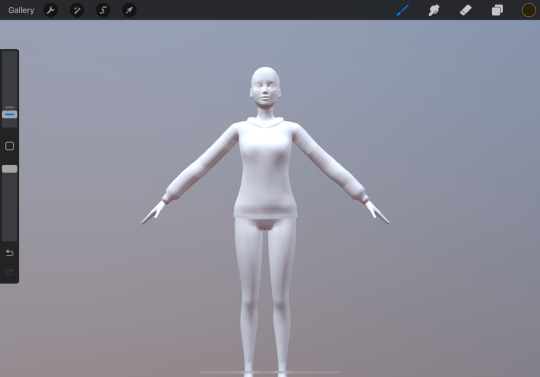
This is where it gets a little screwy lol. Since procreate only seems to support square uvs that are 2048x2048 and Sims textures are 1024x2048, we have to stretch the texture to fit, edit it, then squish it back (this will kill the quality a little, but I honestly can’t figure out a different to do it, please tell me if you know)
5. Color fill the main mesh you are working on (drag the color from the top right corner onto your mesh and drop)

6. Go under Actions (wrench icon)>3D>Show 2D texture
7. Go under Actions>add>insert photo and pick your imported texture and position it up against one side of the canvas
8. Start a transform, then turn on snapping/magnetics. Then, with freeform transform, stretch the texture so it reaches the other side of the canvas, making sure it snaps to each side. You can then position the texture over the colorfilled texture to make sure it lines up

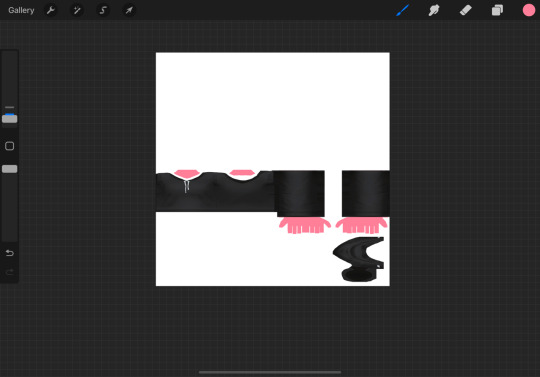
9. Uncheck the show 2D texture option and check that the texture looks right. You can turn off the colorfilled texture too

10. Paint/edit texture normally! I like to work on a separate layer so I can move it around and edit it separately
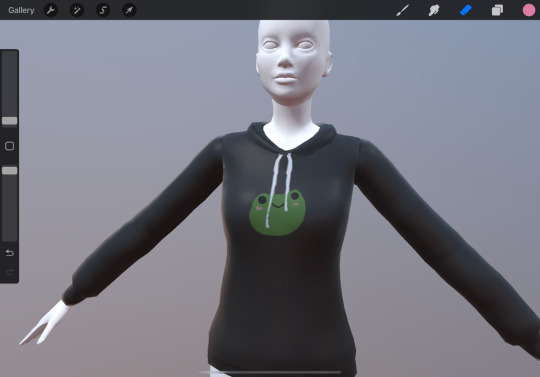
11. You can also insert photos, select areas and move them around, and basically do everything you can in normal procreate, it’s pretty cool :)
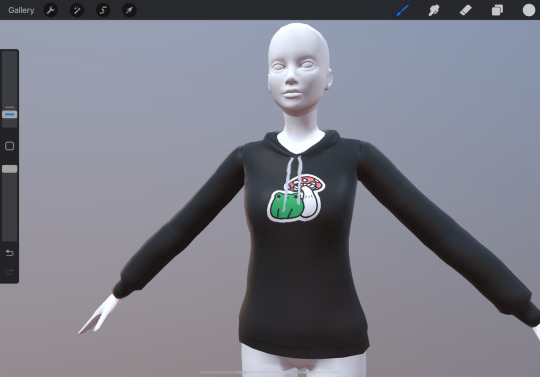
12. Once you’re happy with your texture, go into layers and merge your drawing layer with the texture layer (you could try just exporting the drawing layer and adding that onto the original texture in photoshop, might save some quality but you might not be able to get it in the exact same spot)
13. Go under actions>add>copy canvas
14. Go back into the gallery, add a new artwork, choose clipboard when it asks for a size, this should put the image texture you copied into that new artwork.
15. Save the image from there and transfer it back to your computer
16. In photoshop, select the white background and delete it. Then, copy the texture onto a sims texture template. Then you can free transform one side and squish it back to the right size, and place it so it fits correctly over the template

17. Hide the template and save the image, then import it as a texture into s4s. Tada!

It’s not perfect, like I said you lose some quality, but you can do some cleanup in photoshop and it’s a lot easier to draw directly on the mesh this way if you don’t have a drawing tablet/cintiq to hook up to your computer.
When I tried it the first time, I was working on a new mesh so the UVs were square. When I finished painting, I took that texture and scaled it down to fit on the sims texture, then I adjusted the UVs to fit, which definitely worked better. Hopefully Procreate will fix some things so we can import textures and have non-square uvs. Hope this helped, let me know if you have questions!! :)
#procreate#sims 4#sims 4 cc#sims 4 cc tutorial#sims 4 tutorial#procreate update#procreate 3d#procreate tutorial#ts4#ts4 cc#s4#s4cc
168 notes
·
View notes
Photo


Tutorial - Decor crowds (and decor sims)
Hi everyone! Someone asked me if I could make a tutorial showing how I make decor crowds. Now my university stress is mostly gone so I finally have the time and energy to show the procress.
I am not going to show how to make poses, so if you don’t already know how to make poses, I recommend this tutorial.
This tutorial works for both one sim and for crowds. You just need to skip some parts if you only want to make one sim.
Now, let’s get started.
You will need:
TS4 SimRipper
Sims 4 Studio and Blender (preferably 2.70 if you want to follow along with my tutorial in the same version)
Image editing tool of your choosing, I use Paint Tool Sai, but you can use any that supports files with transparent backgrounds (PNG-files).
I recommend that you create one folder which you work within to keep track on all files, but that it up to your own preference!
Edit: 3/8-2020 Hello everyone! I can recommend checking out this tutorial if you experience any problems with shadows! It’s extremely useful and made by the talented @theroyalthornoliachronicles
Step 1 - Make one or a bunch of sims.
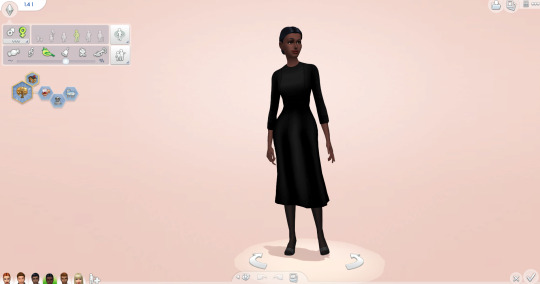
Make one or more sims that you want to have as your decor sims/crowd. Name them something easy like A A or 1 1. Each of these sims are names 1.1 1, 1.2 1, 1.3 1, etc. This makes them very easy to locate later.
When you’re finished, save your game and close/minimize it.
Step 2 - Launch TS4 SimRipper

TS4 SimRipper is super easy to use. Place it in a folder so you have every file at the same place, unzip it, install it and then launch the program. If you cannot find the file, it should be a program file, look below for a guide.
When it launches, press Select (1) and choose the file at the top of the list. Let it load (don’t click anything).
When it’s finished, choose the sim you want to export (2). Again wait, it may take a while but that is normal.
When the sim is loaded, press Save as .dae (3). This is going to also take a while, so you can do other stuff in the meantime. For example, you may proceed to the next step in this tutorial. Remember to name them something easy to find, like 1, 2, 3, etc.
Remember to check if the program is finished every now and then to export the other sims you made.

If you cannot find the program, it should look like this. My system language is Swedish, but it should be named something along the line of program under the type-category.
Step 3 - Export files and rigs from Sims4Studio.

Now it’s time to start making the decor sims. Either start with Objects (1) or Poses (2). If you want a tutorial on how to make poses, please follow the tutorial I linked above.
When it comes to Object (2), choose create 3D Mesh and then the blue button.
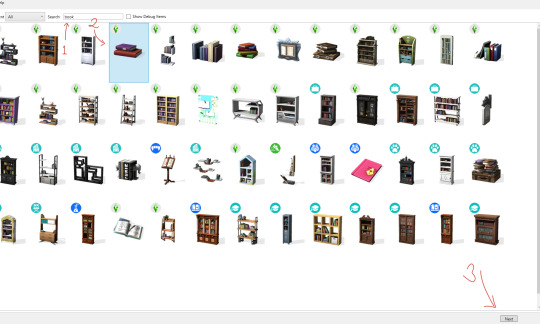
Like my last tutorial, we are going to use these books are our base. Start by searching for them (1), click on them (2) and then press Next (3). Name it whatever, but I recommend a name that will make sense a mod folder.
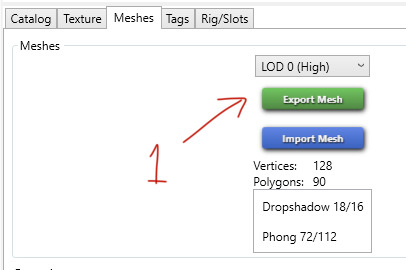
When it has loaded, click on Meshes and choose Export Mesh (1). Again, name the file whatever you want. I named my Grund - which means base in Swedish.
Step 4 - Working in Blender

Open the newly exported mesh in Blender by double-clicking on it. You should be met with something that looks like this.
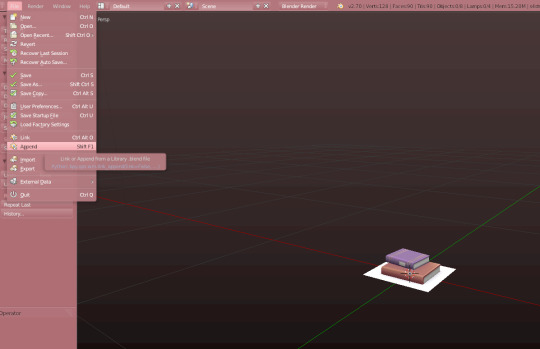
Open the File-folder and press Append, or just click Shift + F1.
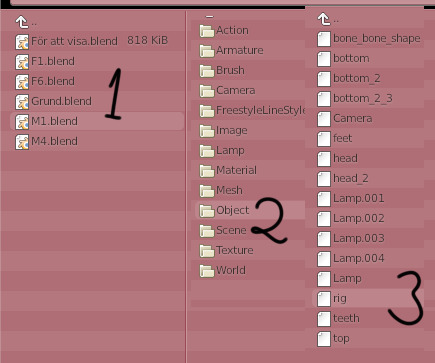
Choose one of the poses you made in advance or just import the rig you exported earlier. I am using a pose from my Mourning pose pack. Click on the pose (1), then Object (2) and finally rig (3). You do not need any of the other pieces in this tutorial.
If you are using another creator’s cc, like a pose, be sure to ask for permission before sharing the decor sim with the public.

When done correctly, it should look like this. This is the sim’s frame which we will base our decor sim on. This rig will be named rig.001, just leave it be.
Step 5 - Import the .dae file
Unlike my last tutorial, this step is super easy and takes almost no time.
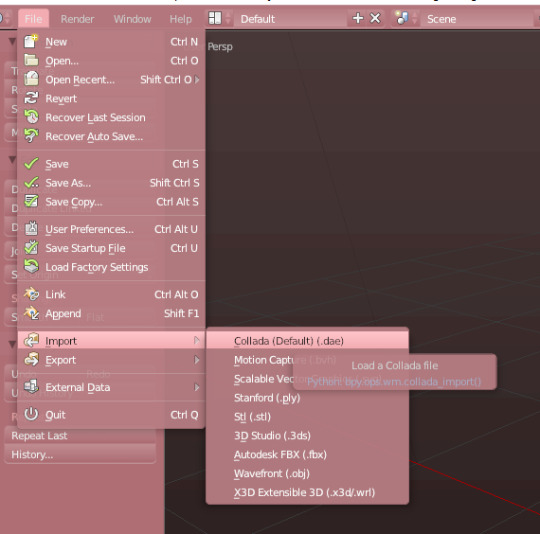
Go to file, then down to Import. Choose Collada (Default) (.dae). This is your sim with its rig and body exported from the game. This means that you can make decor sims of any body size, skin colour or other feature.
Click on any of the .dae files you exported eariler.
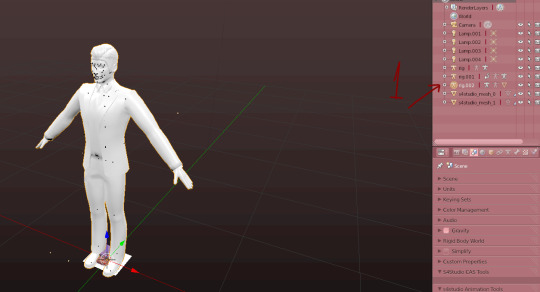
Now you will have a new rig named rig.002. Go right ahead and delete it.
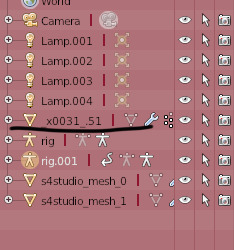
Now the body will be named something like this instead, just keep an eye what it turns into.

Now press the modifier-button (1). Then click on the Object bar on the rig modifier (2). Choose the second rig (3) and press Apply (4).
After pressing the Apply button, you cannot move the sim’s body, so if there is something that needs to be fixed, do that before.
When that is done, delete rig.001.
Step 6 - Preparing the meshes to be merged

Now we’re gonna delete any trace that this sim used to be a moving object. Start by removing every vertex group from the sim. Delete them by clicking on the - button a whole bunch of times (1). Then rename the first UV-map to uv_0 (2) and delete the second one (3).
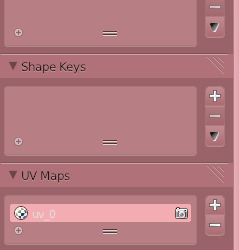
This is what it should look like when you’re done.
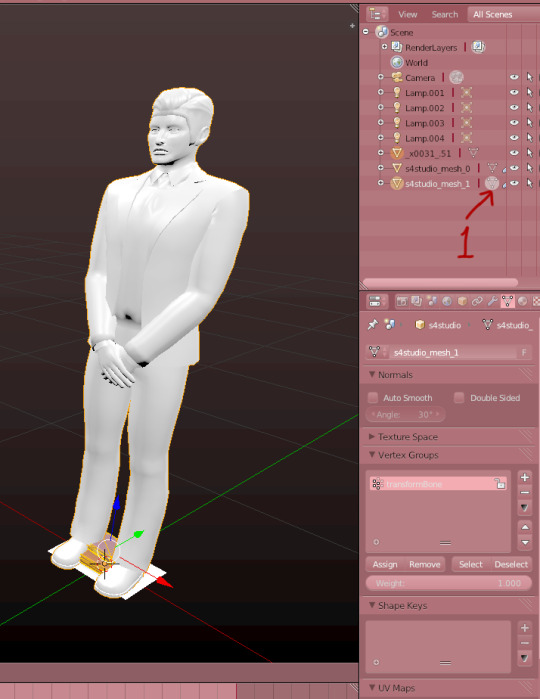
Now we’re gonna merge the two meshes. Start by clicking on the Sims4Studio-file’s thingy I marked (1). Then press A so it looks like it does on the image. When the mesh is orange, press X to delete it. You’ll need its values, so do not delete the whole thing, only it’s mesh.
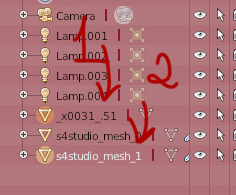
Now, click on the sim in the list of things (1). Then hold shift and click on the S4S-mesh (2).

When they’re both marked like in the picture, press Ctrl + J, or the join button to the left.
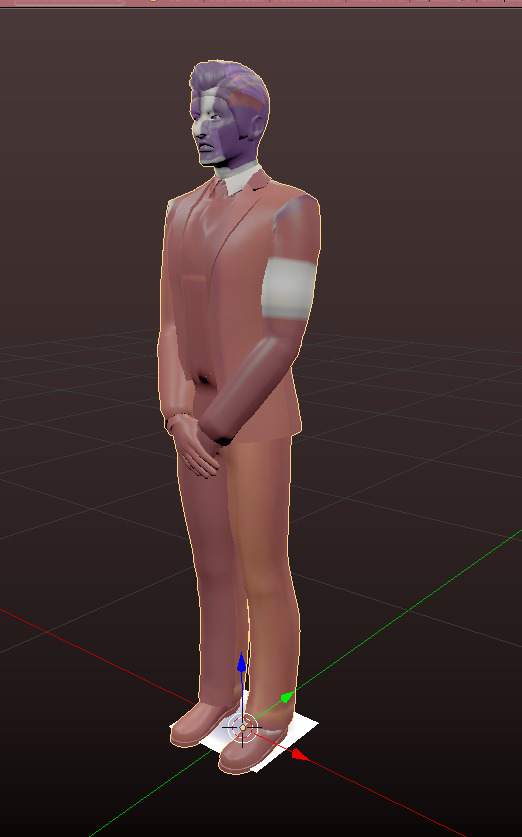
Now it should look like this, if it’s all black, you need to go back and rename the uv-maps to uv_0. You go back by pressing Ctrl + Alt + Z.
Step 7 - Save and finish up the project.

Now save your project before doing this step.
When it’s saved, go back to modifiers and add the Decimate-modifier.

Chance the Ratio to anywhere between 0.6 to 0.8. I usually go with 0.7. Click apply when you’re satisfied.
Save your project again.
If you are only making one decor sim, you’re finished here for now!! You only need to add the other LODs, so you can skip the next step.
Step 8 - Fixing the uv-map (Not necessary for only one sim).
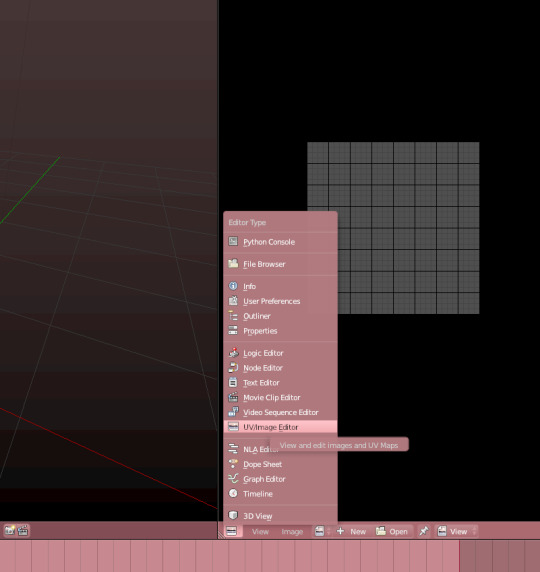
The uv-map is already finished if you are making only one sim, but if you are going to make a crowd, this is a very important step. Don’t worry, it’s really easy.
Open the uv-map by opening a new window and then choosing the UV/imagine Editor. Remember to enter the edit-mode on the mesh.
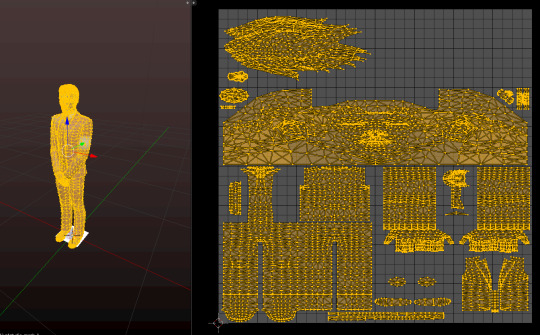
Press A on both windows to highlight everything.
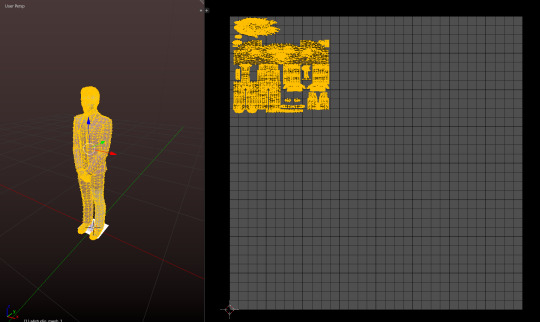
When it’s highlighted, scale it down so that it can fit more uv-maps on it. You make it smaller by pressing S on your keyboard and you can move it by pressing G.
Make sure that it’s big enough to still be able to show textures. but small enough to allow other sims’ uv-maps to be placed beside them.
Now you’re done. Now, redo all the steps you just did but place the uv-map on another spots. You do not want them to overlap or they’ll look ugly.
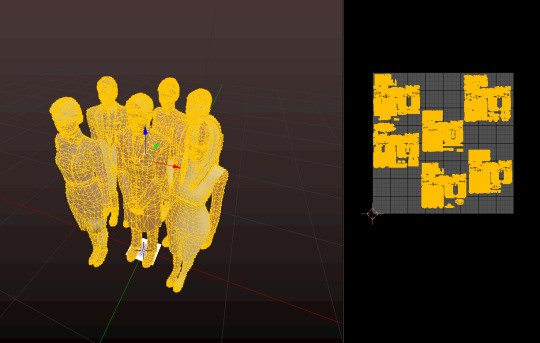
When you done all that, append the decor sims together so they form one mesh and uv-map. If done correctly, it should look like this.

After that, export the uv-map like this. Name it whatever you want.
Save your work again, and decimate the mesh. Try to make it to a 0.5 ratio. This make the crowd more manageable for the game.
Save it again and minimize Blender.
Step 9 - Making the object and fixing the texture.
Okay, here comes the annoying part. Now it’s time for a lot of waiting and to put a texture on your uv-map.
Unless you’re only making one sim, which means that you only need to import both files you just created!

Start by importing your mesh into Sim4Studio. Now this is going to make a while, the more sims you added to your crowd, the longer the waiting. I made 6 sims, so that is a very big file.
When it’s loaded into S4S, save your file, so you don’t lose any progress.
While its loading, open your imagine editing tool and prepare yourself for a lot of fiddling.

Your uv-map should look like this. So now it’s time to open every diffuse map you exported earlier in your editing tool and start matching them up.

When you’ve managed to fix the uv-map, it looks like this. This took a lot of time, as one pixel makes a big difference. Have patience when you do this part.
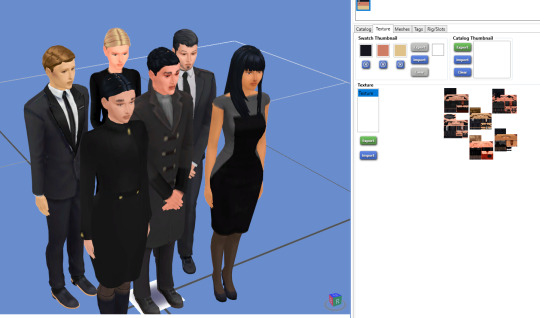
When you take the time, the crowd looks something like this, or hopefully a little more dapper, as mine is quite... depressed.
Step 10 - LODS and Shadow-LODS

ANYWAY let’s fix the LODs. Go back to your blender-file and decimate it with a ratio between 0.6 - 0.8. Again, I use 0.7. Press save and import it into Sims4Studio. Repeat once more for the last LOD. Save between each LOD if you are worried about losing the progress.

Last step in Blender is to make a shadow LOD.
Start by deleting this mesh (1). This is the shadow when you have the “full” object, so now it is just in the way.

When its gone, change the Cut from 1 to 0. This makes it into a shadow mesh. Save and go back into Sims4Studio.

Now you can import that same shadow-mesh into every shadow LOD. Then it’s finished, you’re done!
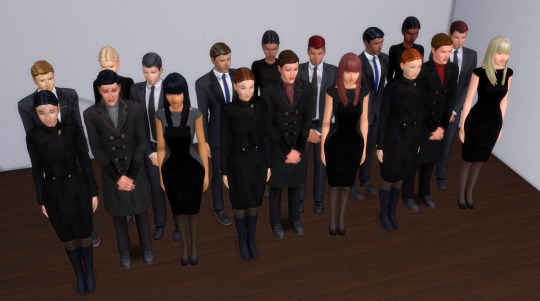
Now all that’s left is to fix the Catalog name, description and tags.
Thank you so much for following my tutorial! If you have any questions, feel free to ask me🌸
394 notes
·
View notes
Note
That Allister cosplay is outstanding!! How did you make the mask and the gym symbol+endorsements? I'm planning on doing an Allister cosplay in the future myself
Thank you so much, and happy to answer! I took lots of pictures through the process so I’ll answer this in two parts.
“How did you make the gym symbol/ endorsements?”
So the first thing I did is take a TON of screenshots I have almost 300 screenshots of reference images of allister and the gym league trainers and the pokejobs logos and so on to get good references for all the logos I needed.Once I was done taking all the screenshots I spent hours tracing them to the best of my ability to create these images: (Not all of these were the final versions which were modified right before printing, apologies)Gym Logo - QUAY/ Gym Logo

XXA - Sponsor (This is the logo for MC Insurance, Allisters Sponsor)

291 - Number

ASTSA - Name (This is the new pokemon language for Onion, Allister’s japanese name)

The square with the diamond - This I nicknamed the “NIKE” cause its the logo for the spotswear company in game

Galar league logo - Galar League logo (this is the logo thats the red and blue pokeball with white marks, and “galar league written underneath it)

And then I put together this ref sheet to make sure the logos looked good together color wise, and some of the colors were still altered later but it all looked pretty good

And then once the logos were all set, I printed them onto heat transfer vinyl and let me explain why I did that specifically. The fabric I used was polyester, which is the kind of fabric that sports jerseys are made of. I did that because the gym’s uniforms are based on soccer jersey’s so it felt fitting!IT WAS A HUGE PAIN I DONT RECOMMEND ITbut now because of the fact that it was polyester paint wouldnt’ work on that fabric because of how stretchy it is and the fact it doesn’t absorb moisture easily. So we printed it onto heat transfer vinyl with my cheap ink printer and then I ironed them onto my clothes! I made sure they were placed correctly by first taping them to my clothes and making a note of the location before ironing it, and then once I was happy with a placement I’d carefully iron it on. This vinyl seems kinda cheap and like the ink might come off with too much water so watch out if you choose to use it. There are also printable iron on paper for other types of fabric as well and are cheaper iirc!
Same goes for the dots, thos were all cut using a CNC/ off brand cricut (just a bunch of circles all at once) and I placed them by hand using painters tape and trimmed as needed to make the designs:

Hopefully that was helpful!
“How did you make the mask?”
So this ones a little more complicated to answer because its not complicated but its not something everyone can do.
So we started on this one before the game came out, and before I’d gotten to Allisters battle in the game but we had enough reference material to figure out the general look of Allister’s mask, so we made a 3D model of it that we planned to 3D print (my bf has a 3D printer and a CNC and helped me a TON for this project) and did a test print of a tiny mask to start to make sure we were happy with the 3D model (here is the tiny mask in my tiny hand, we affectionally nicknamed it “mini mask”)
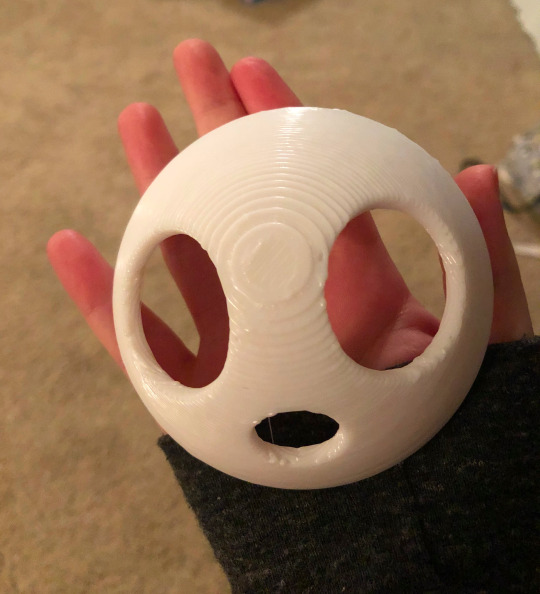
Now after we had the 3D model we had another issue of how big does it need to be? I have a round head on my own so I didn’t need to modify the shape of the mask thankfully (one time my fat head came in handy!) But we needed to figure out how big to make the mask to make sure it “fit” correctly.
So we tried cutting out a circle with paper in a few sizes until we thought we found a good size for my face (which for me was a little over 7 inches)
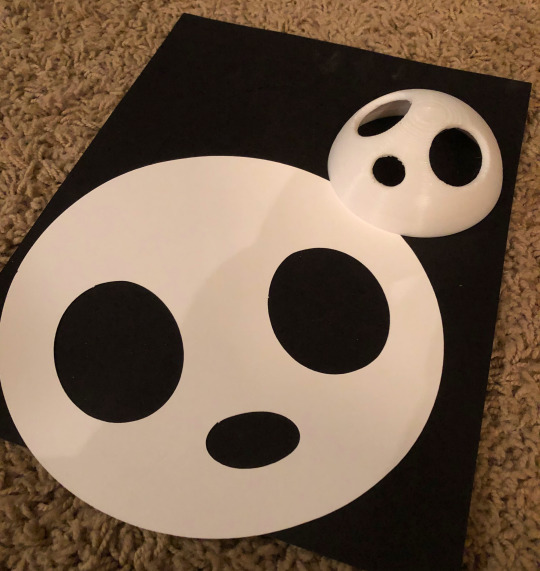
went and bought a styrofoam dome from the craft store in that size to make an EVA foam dome and then checked if that fit my face (later this worked fantastic as a way to transport the mask as a protective shell around it) I don’t have a picture of this EVA foam dome but all it was used for was putting it on my face and making sure it went over my chin and such. Once we had that we were ready to start printing the final mask.
Once the 3D model was scaled for the final mask, it was too big for my bf’s printer to print all in one go so we split it into 4 pieces. Each piece took about 9 hours to print, and a few of the prints failed and had to be redone, so after a few days of printing it looked something like this:

for those who don’t know much about 3D printing all those beams are the supports that lets the printer print raised surfaces like that and have to all be removed. So after about 2 hours of pulling plastic with pliers it looked more like this:

so we left small gaps in the edges of the mask so that we could put metal pins between each piece to help hold it together so we cut our metal pins and assembled the mask and it was starting to come together!

So from here we melted some plasitc onto the seams (plastic welding!) with a wood burner and - wow that looks gross
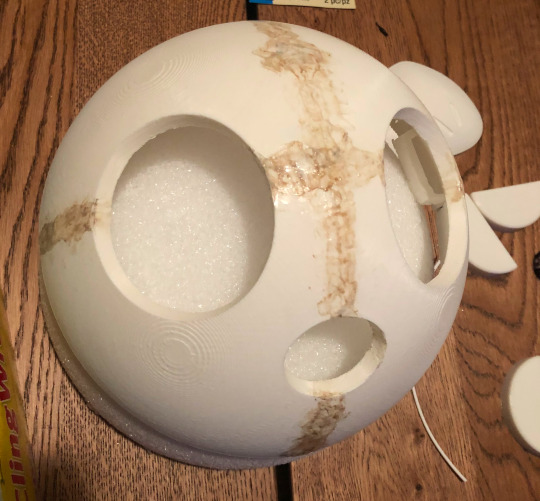
but trust me its better than gaps in the mask. so after a bit of sanding here we entered the rounds of priming it with spraypaint primer and sanding it for like an hour and doing that again, occasionally using bondo putty to try and even out those seams and those rounds tended to look like allister just murdered a village:
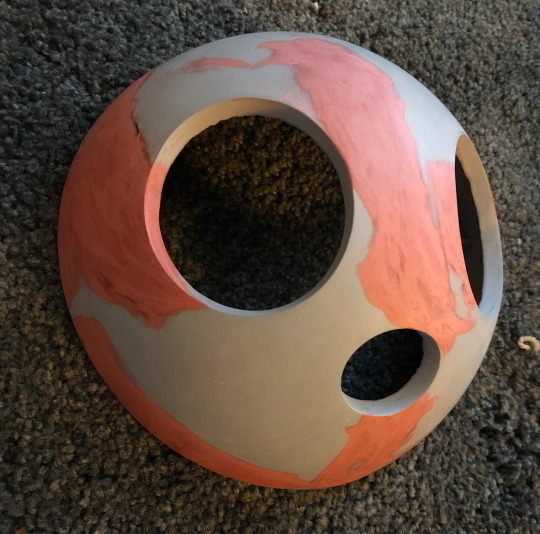
but you can see compared to the previous image that the mask is a lot smoother! This was the final round of sanding and you can tell that most of the layer lines from the printer have been sanded down! You can almost not see the seams anymore! (though now they’re also very red but they’re very smooth in comparison to the beginning trust me…I sat there sanding for many hours for this)
But after this all that needed to be done with a final priming in grey, and then painted it gray!
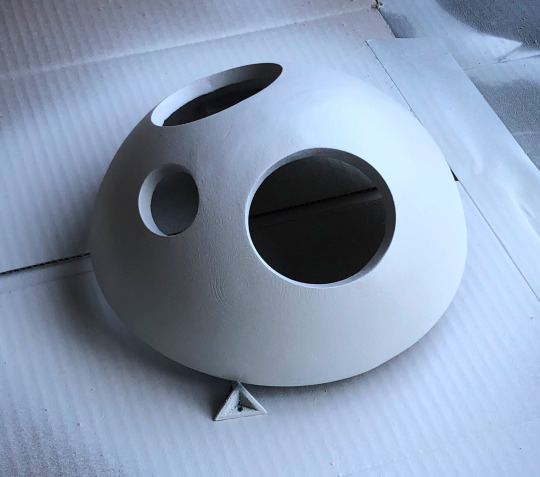
While the paint was drying, we prepared some masking in the design of allisters mask which if you don’t know what the full mask looks like I wanna reference this from the collectors guidebook (which I just now got my hands on today but saw these on twitter)

So we cut out a sticker sheet in that design and placed it down with some painters tape to keep that part of the mask gray and then it was painted white, and that was the painting done!
For the black in the eyes, I got a scrap of black fabric for cheap at joann’s that I picked up and pulled and it was a very soft polyester/spandex material that you’d use for pantyhose so i’m sure you could also cut up some of those for a similar effect. But when stretched you can see out of them.
So we made small rings the same shape as the inside of the mask behind the eyes, glued the fabric using super glue to that ring (and the mouth as well) and viola:

and then the final step was to get that mask on my face, and basically we had some rings on the left and right sides of the inside of the mask that I attatched some elastic too, and then needed to glue a third strap over the top of my head. and sewed it all in place and put some craft foam along the forehead and chin inside the mask for some cushioning and it was done!
I really hope that was helpful and I tried to make sure I took lots of photos along the way so I hope they were helpful. If you have other questions feel free to ask! Sorry for the novel but just wanted to be as detailed as I could be!
Thank you for your nice words and best of luck!! Allister is a detailed boy but he’s very fun!
#my cosplay#allister cosplay#allister#gym leader allister#cosplay help#cosplay reference#allister reference#galar#swsh cosplay#cosplay description#ask#answered#long post#if theres other tags I should add let me know#anon
101 notes
·
View notes
Text
1. Your Final Major Project
What is the title of your Project? What do you aim to produce? How does this relate to your work and ideas from your programme so far and how does it extend your knowledge, understanding and creative ability?
(guide: 150 words)
‘Exploring the self through history of arts iconography’. I aim to produce work that explores ‘the self’. Specifically, the attributes one wishes to project, as well as those that one would like to conceal. I plan on achieving this through a visual conversation, using iconography in art ranging from ancient to modern. I am intrigued by and intend to use and play with the symbolism of these objects, poses, and backgrounds; in order to gather a greater understanding of ‘the self’. I will be continuing to world build which I plan to execute through various forms of portraiture. Recommencing my exploration of narratives through surreal and playful imagery to embody a reality. I expect this to extend my knowledge of symbolism in the visual world, my understanding of myself and others, and to push my creative ability by using traditional imagery in a current, relevant, and honest way for myself and subject matter.
2. Influences, Research, Sources and Ideas
What are your influences, starting points and contextual references and how are they relevant to your ideas? What subject areas do you intend to research and what are the likely sources of information (media sources, museums, specific locations, performances, etc.) you plan to use? You do not need an extensive list in this section, but include your bibliography in the Appendix, clearly identifying all references including texts, periodicals, websites, etc.
(guide: 150 words)
My initial artistic influences are Tim Walker because of his exuberant world building using sculpture and set, Cindy Sherman due to her creation of narratives and character through costume and prosthetics, and William Blake owing to his narrative work in which his own iconography was created, as I intend to also do.
Potent symbolic imagery such as in Hieronymus Bosch’s Garden of Earthly delights, and folkloric work of the medieval period for example ‘the unicorn tapestries’. Are relevant to my exploration of ‘the self’ through symbolism and dream like world building. Through Academic references, books, documentaries, exhibitions, films, and gallery spaces I intend to research into visual iconography, religion, and gender. To enrich my knowledge and in doing so be able to create works not only symbolising ‘the self’ but having a conversation of what the subject’s self represents currently and historically. Hopefully exploring, gender, ‘morality’, religion, myth, and lore.
3. Techniques, Processes and Timescale
What techniques and processes do you intend to use? Describe the range of media and materials relevant to your project and how you may use them to explore and develop your ideas. Include aspects of studio practice, workshop procedures, or the use of particular equipment and software. Give an indicative timescale for your project and how you intend to plan your time in order to investigate, develop, produce and evaluate your project fully. This could be a daily or weekly schedule. (Please attach at the end of this form.)
(guide: 150 words)
I intend to use the studio photography room when creating film and photographic portraiture, so I can utilise the set lighting and take clear pictures to enhance the scene created. This will give me the freedom to explore different compositions and see how that effects the portrayal of ‘the self’. The objects I plan on creating to build these iconography based narratives will vary in material. I will make ceramic glazed sculpture to enhance the attributes of the certain objects, for example a pearl. I will use screen-printing to experiment with the images I have created, this medium will allow for a discussion with colour and sizing. Painting set backgrounds will allow for explorations into landscape iconography. The use of film with allow me to create a narrative not only through sculpture but a moving story with them. Using mud rock will enable me to play with size and create wearable work. Perfect for my dream-like world building.
4. Method of Evaluation
How will you critically review and analyse your work and determine if it is successful? How will you identify directions for ongoing development? Do you have a method to record the critical response to your ideas? How do you propose to assess the success of your Final Major Project and what will be your methods of evaluation?
(guide: 100 words)
I will critically review my work by continuously evaluating it, seeing if I have pushed it and myself to its fullest potential, visually and conceptually. Analysing it through its relevance, contextual, and visual strengths, realises successes and flaws and building upon them. The direction for my ongoing development will be identified by my interests in research and what media I find works well with my concepts. Continually evaluating the relevance of concept, context and material. Responses to my work and ideas will be found in tutorials and peer evaluations, which I will seek out weekly. This important information will be kept in my sketchbooks and blog. I plan to assess the success of my final major project by reflecting on all my work and writing an evaluation.
5. Appendix
Include an appendix for the bibliography and any other relevant material for your Final Major Project.
Compile an accurate bibliography before starting your project, that correctly acknowledges all references including texts, books, websites, magazines, films, documentaries, museums that you will study for initial research on your project.
1. Gibson, W. S. (1973). Hieronymus Bosch and the Mirror of Man: The Authorship and Iconography of the" Tabletop of the Seven Deadly Sins". Oud Holland, 205-226.
2. Gibson, W. S. (1973). The Garden of Earthly Delights by Hieronymus Bosch: The Iconography of the Central Panel. Netherlands Yearbook for History of Art/Nederlands Kunsthistorisch Jaarboek Online, 24(1), 1-26.
3. Marrow, J. H. (1986). Symbol and meaning in northern European art of the late middle ages and the early Renaissance. Simiolus: Netherlands Quarterly for the History of Art, 16(2/3), 150-169.
5. Bragg, B. (2019). Advertising Antiquity: The Cultural Utility Images Of Antiquity Enjoy In The Commercial Lexicon. Plan II Honors Theses-Openly Available.
6. Wardle, J. (1978). Blake and iconography: analogues of Urizen and Vala. Colby Quarterly, 14(3), 4.
7. Cosgrove, D., & Daniels, S. (Eds.). (1988). The iconography of landscape: essays on the symbolic representation, design and use of past environments (Vol. 9). Cambridge University Press.
8. " Holland, N. N. (1959). " The Seventh Seal": The Film as Iconography. The Hudson Review, 12(2), 266-270.
9. Straten, R. V. (1994). An Introduction to Iconography: Symbols, Allusions and Meaning in the Visual Arts.
10. Kosmopoulou, A., & Templer, W. (2002). The iconography of sculptured statue bases in the Archaic and Classical periods. Univ of Wisconsin Press.
11. Easton, M. (2012). FEMINISM. Studies in Iconography, 33, 99-112.
12 Cohen, S. (2014). Review Essay: Animal Imagery in Renaissance Art. Renaissance Quarterly, 67(1), 164-180.
13. Cavallo, A. S. (1998). The unicorn tapestries at the Metropolitan Museum of Art. Metropolitan museum of art.
14. Janick, J. (2010). Plant Iconography and Art: Source of Information on Horticultural Technology. Bulletin of the University of Agricultural Sciences & Veterinary Medicine Cluj-Napoca. Horticulture, 67(1).
Week 1
Lots of research in order to build a foundation of knowledge. Experimental work in reaction to research. Using sketchbook as well as blog to record every thought, experiment, relevant conisation and piece of research.
Week 2
Continuing research; I plan to have completed reading most of my academic references by the end of the week. Documenting and experimenting in sketchbook and blog. I will start to build large scale sculptures in accordance with iconography of objects I connect to.
Week 3
Documenting and experimenting in sketchbook and blog. I will have researched into the iconography of poses, the body, and landscape and will make costumes and set backgrounds in accordance with my research and experimentations.
Week 4
Documenting and experimenting in sketchbook and blog. I will go do a workshop on ceramics and go into the ceramic studio and experiment and create objects relevant to the media.
Week 5
Documenting and experimenting in sketchbook and blog. I will use the photography studio to experiment in creating portraits using people and my props. I will go into the dark room to experiment with the images produced. Working towards a final outcome. I will experiment with film.
Week 6
Documenting and experimenting in sketchbook and blog. I will do a course in screen printing and experiment with previous images created in the photography studio as well as creating new work. Working towards a final outcome
Week 7
Documenting and experimenting in sketchbook and blog. I will be finishing my final project
Week 8
finishing touches on work, continuing to document, finishing, handing in work.
1 note
·
View note
Text
Side Effects Include: Empathy
Chapter 5:
As the window closed in Lila’s face, Adrien’s apologetic expression turned to one of pure relief.
He looked forward again, and saw his driver giving him a quizzical look. Then, without a word (well, without a word wasn’t exactly a surprise) they were leaving.
It wasn’t until they were well out of sight that he could start thinking ahead, but when he did…
He needed to talk to Ladybug, that much was clear. Beyond that, though, everything was blank. Blank, because for maybe the second time since he’d met her, something was making him reconsider his crush on Ladybug.
Besides that, he needed to ask Plagg, needed to be certain that the feeling in his stomach when he thought of Marinette wasn’t a fabrication, or some magical effect of touching her, because, if it was…
His heart sank further. If it was, how could he ever know for certain that his feelings were real, and not some mirrored delusion? And then, what if it wasn’t!? Would that really be… Any better?
Plagg had said he’d have fun with this, but Adrien was beginning to doubt it.
What he wanted to do was ask Plagg, but… He’d have to wait if he wanted to do that. He wanted to talk to Ladybug, but he’d have to meet her in costume, and he couldn’t transform right now, either.
Yet another part of him wanted to just go, visit Marinette, and let the beat of her heart drown everything else out.
Let the beat of her heart drown everything out? Really, Agreste?
He pinched the bridge of his nose.
Plagg first. It had to be.
The good news was, of course, that there was nothing stopping him from just… Doing a bit of finagling with his piano practice. After all, it wasn’t like anyone was going to randomly come and check on him.
With that thought in his mind, he just, had, to…
…
Wait.
A few minutes of scales to make sure Nathalie had time to walk away, and…
He queued up a recording of one of the pieces he was supposed to be working on, and set it playing.
He stood up.
“Plagg? We need to talk.”
Plagg floated into sight.
“Yeah… Figured you’d want to. Alright, what’s the problem?”
“It’s… About Marinette.”
“Why am I not surprised?”
He sighed. “I guess you already knew she liked me, huh?”
Plagg… Didn’t answer.
“Well… It’s actually, also about my new powers.”
“Not surprised.”
“I…” he almost didn’t want to say it out loud. “I was wondering… After… After what happened with Marinette, and she, ran into me…” He closed his eyes, and took a breath. “It feels like I like her back.”
There was a long silence. “And I’m supposed to…?”
“I- I don’t know. I just need to know if I feel like that because she feels like that, like, something about my new powers makes what other people feel stick with me, or if… If that’s just… Me.”
“Just you. I mean, obviously you wouldn’t be feeling this if you hadn’t touched her, but it’s not, like, magical.”
“So… So I do, actually… Like her.”
Plagg shrugged. “Maybe. Or maybe you’re just a stupid romantic, who’s overly excited that someone likes him.”
Adrien stopped.
He looked at Plagg.
Plagg shrugged.
Adrien sighed.
“I dunno, that’s not exactly, my thing.”
Adrien stared blankly at his kwami.
The music from the top of the piano seemed a strange backdrop to the peculiar dissatisfaction that was sinking into his stomach.
Sure, there wasn’t anything magical about what he was feeling, but… Plagg had a point.
Maybe what he felt for Marinette was a fabrication of his mind.
The void in his stomach sank a bit deeper.
What if his feelings for Ladybug were just desperation, too?
What if-
He let out the low moan that would have been more at home in the mouth of someone turning over in their sleep.
“Plaaagg?” he said.
Plagg gave him a look.
“Plagg, you’re giving me an existential crisis.”
If Plagg had had eyebrows, he would have raised them.
“Oh! Well that’s nice.”
“It’s not nice, Plagg.”
“Well, it’s refreshing.”
“Do I even really like Ladybug? Or is it… Is it just that she was one of the first people I met? What if Ladybug had been someone else? How bad would she have had to be before I wouldn’t have fallen in love with her?”
“I dunno, not my business.”
“Plagg…” His tone was almost pleading.
“What? You really want my advice? It’s been millennia since I’ve been young enough to have any idea what you’re feeling. I just eat cheese, and watch things disintegrate, and I’m happy. You humans are weird, with your whole… Picking people, thing. I don’t know, maybe you’re just easy to please, but you didn’t fall in love with anyone else that whole time.”
“Yeah, and all it took was Marinette… Well, not telling me, but… It’s like she told me, without knowing it.”
“Mm.”
“What if it had been someone else!? Would I be feeling like this about them now?”
“I seriously don’t understand why you’re asking me this question.”
“Because how am I supposed to…” He trailed off. What if… What if someone had told him that Marinette felt like that about him, yesterday?
Well, for a start, he’d have laughed them off.
What if… Marinette herself had told him? He tried, for a second, to forget what he now knew.
If she’d come up to him, told him to his face, and left before he’d had a chance to think on it…
He’d have been flattered, of course. After all, it wasn’t everyday someone as great as Marinette told you… Of course, what did that even tell him? Of course he’d be flattered. It was Marinette for crying out loud, anybody would be flattered!
Or… Would they?
His mind seemed to twist, under the almost paradoxical question. Would he be flattered, and, presumably, feel like this, because Marinette was great, and anybody would be lucky to have her, or did he think anybody would be lucky to have her because, on some level, he’d already felt like this?
Surely it wasn’t normal to look at someone, and write off liking them because it was too obvious.
And Ladybug…
Well, of course, she could easily have been a celebrity crush, but it wasn’t like that. He knew her, personally. And it felt like he fell in love with her a bit more every time he saw her. That didn’t, sound like he was just fooling himself.
So… What. He had a crush on two people, now? At the same time?
That was… Allowed?
Apparently.
He sighed.
Well.
No matter what, he still had to talk to Ladybug.
And to get there, he needed to finish his piano lesson, to get the eyes of the world, or, Nathalie, at least, off him.
He walked back to the piano, and…
He blinked. His phone, plugged into the player, had a notification on it. Looking behind him, he sat down, and retrieved it.
For a second, his heart felt strange; It was a message from Marinette.
He took a breath, and opened the message.
He let the breath out, because… Had he really been expecting some declaration? No.
“We need to deal with Lila. I’ll be busy for a while, but hopefully I can text you at 6.”
“It’s a date.”
“Sounds good to me.”
He sighed.
He really didn’t like the idea of making Lila angrier than she already was, but they had to do something, didn’t they? If they just left her to her devices, maybe she wouldn’t turn into a supervillain (not to say she didn’t have a surprisingly itchy trigger-finger for it, so to speak) but… She was malicious, and altogether too powerful; too many people trusted her, listened to her. Even he had misjudged her, and he had known she was a skilled liar.
Well, at least the timing would give him a chance to talk to Ladybug; A chance, because there was no telling whether she’d even be out and about at the same time as him. Hopefully, he’d have chance to talk to her, and clarify his feelings towards Marinette. With any luck, it would be easier to talk to her when she did text him.
…
When Ladybug landed on the rooftop, a little unsteadily, he was reclining against the shingles, lounging out as if he was utterly relaxed.
The image was, of course, far from the truth, but he was Chat Noir. He didn’t get nervous.
Ladybug straightened up, and caught sight of him.
He grinned, another fabrication, and gave her a cheery wave.
“Lovely weather we’re having, isn’t it?”
She gave him an unimpressed look.
He straightened up, and let the grin drop. “Yeah… What brings you out today?”
She shrugged. “Probably the same thing as you.”
“The beautiful day?”
She didn’t respond.
He sighed. “New powers?”
She still didn’t say anything, but from the shift in her posture, he knew he’d hit the number.
“Yeah… Me too.”
She sighed, looking at him. “More trouble than they’re worth?”
He shrugged. “Maybe? What did you get?”
She scoffed. “Strength.”
“Oh. Well that actually doesn’t sound too bad.”
“Yeah, well, you’re not me! I can barely walk without tripping over my own… Well, maybe that’s uncharitable, but I’m not exactly graceful, at the best of times, and now it feels like I’m kind of out of control, even as Ladybug! The first time I jumped, I completely overshot where I was going, and landed on the next roof.”
He laughed. “Well. I’m sure that’ll get better with time, right? I mean, if I recall correctly, you didn’t exactly know what you were doing the first time we met. I bet once you get used to it, you’ll be even… Well, stronger is the wrong word, but better.”
“Yeah… Maybe. But what about you? You said you’d gotten a new power of your own?”
He sucked in a breath, and let it out.
“Yeah… Yeah I did.”
She looked a little concerned. “You okay there, Kitty? Nothing went too wrong, right?”
“No! No, I just… It’s a weird one, and it’s got all this… Thinking you have to do.”
“Thinking isn’t your strong suit?”
“I mean… Not as much as yours.”
“Well? What is it?”
“I can feel people’s emotions.”
She blinked. “You can what?”
“When I touch people,” he said, “I can feel whatever they’re feeling.”
“That’s… You’re… Are you serious?”
“Do I look like I’m joking? If you want, I can prove it.”
“I- Yeah, sure, go ahead,” she said, shaking her head as if somewhere between confusion and disbelief.
“Well,” he said, stepping up.
“Oh. Right. When you touch them, and… There’s nobody else around.”
“Yeah, it’s- If you don’t want to, I can-
“No, no, it’s fine, I don’t really have anything to hide. At least, not right now.”
He nodded, and reached out.
She closed her eyes, and he pressed his thumb against her forehead.
//
Ladybug is calm, and collected. There’s the disbelief and confusion there, mild, but present. Beyond that, she seems at ease, which, he has to say, is flattering, given that he has his hand on her forehead, and could technically disintegrate her at will. No fear at all.
Ah, but he’s off course, is he. He pulls himself back, and tries…
The mind behind the emotions, is… Familiar? He can see it clearly, as if looking at the bottom of a pool, when the water is clear, and still. Too still, in fact. He tries to find emotion, and just finds himself running into… What she is behind her emotions, he supposes.
“You’re… Well, not feeling anything in particular. I’m not sure what you expect me to tell you if there’s nothing to sense.”
“Well,” she says, “I can’t exactly, just, change my mood.”
“Mm…” he says. “Well, I could try.”
She laughs, and he wishes she hadn’t, so he could have known she was amused without it having been obvious.
“Uh… Oh, what’s a good one… Well, the weather’s nice, but every day beautiful when you’re around.”
The response is… Almost nonexistent.
“Really doesn’t land, huh? Probably works better if it’s spur of the moment.”
“I mean, the fact you’re not insisting it did ‘land’ is pretty weird, for you.”
He sighs, and lets go.
//
“Yeah… I mean, it’s kind of a paradox, right? If you’re experiencing strong emotion, either you’re trying to hide it, or you’re not, and either way, I’m not sure it’d do much good to go feeling around for it.”
She laughed. “Yeah… I do believe you, for what it’s worth. It’s just, kind of strange.”
He sat down. “Right. Right.”
And what had he gained from this? She wasn’t secretly in love with him, which honestly… didn’t surprise him. Then again… If nothing else, there hadn’t been any annoyance, or mistrust, or doubt… Really, Things could have been so much worse.
She sat down next to him, and for a while, nobody moved.
“I’ve still got a while before I need to be anywhere,” he said.
“Yeah. Same here. And then…” she sighed, “There’s some stuff I need to handle.”
They stared out across the city, the sun still shining down.
It was a beautiful.
“So… how far do you think you could throw me?”
56 notes
·
View notes
Text
The Odd Heart Girls II
The days making my way without someone at my side were over. The long winding streets littered with empty faces all looking to reach a similar place. My father always told me it was the human in me that made me feel alone. That snakes can live forever in solitude, that the weakness of the flesh made us crave the unreasonable. In my head, and in truth. Though at the time I was little, the flesh sat under a layer of scales. And perhaps that way of looking at one’s self was from a bygone era. I was told getting stared at was normal. That it happened and would happen until the end of my time. It gave me a stark look at the world. In that, I was alone until I caught her gaze…
At first, she seemed like every other two-legged human, looking around at my intruding body, that sat coiled up to make space for others. But it just kept happening, day after day, if I caught her in the act her face burnt pink, or she’d pretend to stretch her neck. It was this girl I fell in love with, we had our first moments together in a park, away from everything else. We talked about it, well I talked about it, she was to embarrassed to do anything but nod. I found that her standoffish nature was a part of her, maybe she was intimidated by me. The teeth the slit eyes, and standing proper I was two feet taller than her. I tried my best to appear on her level, keep it close. We walked together, everyday after that, she for a long while paced a little behind. Soon we shared a room, and seemingly no time later, owned a small place together. We became transfixed on each other’s happiness, and we found that through an understanding and pleasure.
She loved my heart, an odd desire but one I could get behind. Having the two, it was almost destiny my partner be obsessed. Our roleplays shifted after that, from predator prey, a favorite of mine. To listening to one another’s hearts, and tearing them out from each other’s chests. She came alive in those moments. Called herself a freak for them, I was just tickled to death anyone even liked a snake, let alone enough to desire one’s heart. The cold creatures we seemed to be labeled as. It came to my attention, that I was unsure what I would do without her. This meant caring for myself as well, something that was slowly catching up.
I was a large snake, but small for my size if that makes any sense. My mother was almost eight feet longer, my father more so. I was small, and my human half though gifted in many ways, seemed thinner. Perhaps that was why I liked acting the predator, my mind knowing that in a different world I might be dead.
It happened a week before, we had slept in the living room the only space with cool air for her, I enjoyed the heat of course. I kept waking up twice a night in cold sweats. A tightness in my chest during classes. I figured it to be a cold, the chest pains I blamed on our eccentric heart play. God knows my breasts felt as though they went through a cheese grater. My center red from fixated fingers and stethoscopes.
She was not there and that was fine not her fault. Though, she blamed herself for it afterwards but without her, I would not be here. At home, in the middle of one particular heated day, both in temperature and myself. I was cleaning the ceiling fan, to do so I just rose upwards a clever and useful talent. Thinking I had electrocuted myself. My arm felt a shock of pain, at the same time a straining burn in my back. Gently moving down, my breath shortened. I grabbed the center of my chest, like she had playfully done a hundred times before. Only this time I prayed it to be torn out. Collapsing to the ground, my human half laid on top of my mid-section. The part of me that was thickest, where my other heart was. It was surreal listening to the pounding of one heart and feeling the slowing burn of another. I couldn’t call anyone; I couldn’t move really. The bight outdoors blurred, and the room fell a mixed shade of woods to one of brown. My heart, my center was dying fast. I had been told one of my kind did not need the human heart. But this required surgery, to organize veins and arteries correctly. Now in my last pathetic moment all I could hear was that little heartbeat. Hers, remembering its fast-high pitch rhythm. In contrast to mine own. My eyes closed, and my mind faded to memories of her like watercolor.
I felt an even sharper pain under my ribs, enough to jolt me awake again. A cold hand wrestled my bones away, and a wrapping of fingers around an object I knew not its shape until then. She squeezed, over and over massaging my heart, crying for me to stay alive. “You finally reached it...” I weakly said, either as a joke or as the last thing I could think of. The massage went on for hours it seemed, trying different paces, squeezing fast and slow, a moment or two stopping all together to run a shaking hand across my cheek. The sirens wailed from outside, the noise grew closer and closer, finally the black took me. I couldn’t tell you if I said good-bye or I love you. Just before that, but something came out before my breath ended.
~
I had suffered a heart attack; I was too young I though waking up in the hospital. But then no one is too young to die. My parents visited, thinking the girl who stayed every night by my side was just a good friend. My father and mother thanked her relentlessly for saving their daughters life. My bastard brothers even showed up to make little jokes. It was a long while before I was let out, the first thing I did was stretch myself all the way out, having been curled up for weeks. I rested in the living room, where I was most comfortable. Feeling my heart loud and clear now more than ever. the scar from my lover still stitched up a long-jagged gash that for me represented what we would do for one another. Though I never got the chance to repay her in that fashion. She was fit as a fiddle she’d tease. I could never repay that debt, only ever please her in every way. Make her feel her best self every day.
Despite my brush with death, I never suffered another attack, chest pains now and again, and a rough trip through cardiac rehab made me double down on a healthy lifestyle. A year later, most of my strength was recovered. I had the gift of youth the doctors all paraded. Even thought I felt much older for it. She, always came with me to my appointment and visits, and asked to help me with everything. I was not a cripple, and she was well intended. I could lift a heavy box, go running, I enjoyed her company. But I assured her I would not die getting the mail.
I had never been one for tattoos never even considered it, but this one was necessary, a tribute. When her hand had reached deep into my body squeezing my dying organ for as long as she could. I felt the outline of my own heart. Or maybe I had just made it all up in my head either way. I drew it vaguely on myself an artist re-imaged my copy, now I had three hearts. Two for myself, another to remind her of what she did. And all three were hers.
-End
~Hello, this is Beckyferalfluf. I hope you enjoyed my stories Though English it not my first language. I’d like to think I have the ability to work stories together for you to read. Having read other heart related content. Mine is not as intense or straight forward, but hopefully you are enjoying the characters and the story for what it is. Hoping to write more in the future. CaptRedHeart, is my Tumblr connection to the world.
-Ta Ta!
43 notes
·
View notes
Text
Heavy
As requested by @jessforthethrone. I hope its worth the wait!
“Arya! What are you doing?” Gendry quickened his pace to catch up to her on the seemingly endless steps. “The maester told you not to lift anything!”
“You misheard him,” she insisted, continuing upwards with the small trunk in her arms. “He told me not to lift anything heavy and this hardly weighs a thing.”
It was true, in a sense. The trunk barely strained her arms as she held it in front of her, mindful of the little bump between her hips that was becoming more pronounced by the day.
But Arya didn’t measure the weight of its contents by the physical strain they caused her. Every item inside was sure to be heavy on her heart, and she wanted to bear that weight alone.
“I’ll take that.” Gendry lifted the trunk from her arms, ignoring her protests and hurrying up the rest of the stairs to the lord’s chamber. “What’s in here? It keeps rattling around,” he said, setting the little trunk on the bed.
“Sansa sent it,” she said shortly. “And I could have carried it myself.”
She perched on the edge of the bed, tracing her fingers over the direwolf painted on the dark wood.
As if reading her mind, Gendry came to rest a hand on her shoulder. “Do you want me to leave?”
She’d told herself that she wanted to open it alone, but now that the time had come she found her fingers hovering over the latch in indecision. “Stay,” she said, voice just barely above a whisper. “Open it with me.”
He kicked his boots off and climbed onto the bed behind her, pulling her onto his lap so he could see over her shoulder as she flipped the lid of the trunk open.
“I believe this is the noise you heard.” Arya reached in and pulled out a little rattle, shaking it for emphasis.
“What’s this made of?” Gendry took the toy from her hand to inspect it.
“Wood and dried seeds, if I remember correctly. I had a metal one but my mother had to replace it with this because I threw it at Robb and Sansa’s heads.”
Gendry laughed at that. “So you’ve always been antagonistic?”
“They antagonized me,” she insisted. “I was just defending myself.”
The thought of Robb weighed on her heart. Avenging him had been sweet, but she couldn’t help thinking of all the things she would give up for him to be there with her again. No matter what happened, no matter how much time passed, a part of her would always ache for what had been stolen away: Robb’s laughter, her mother’s voice, the little niece or nephew that had never even had the chance to draw breath.
Gendry chuckled at the image of his wife as an infant, tiny and full of anger with her siblings. “Well, hopefully the little one doesn’t have your aim.”
“Worried she’ll get you in that thick skull of yours?”
“Yes, I am,” he admitted tickling her behind the ear in retaliation for her teasing. “You think it’s a girl?”
Arya shrugged, pulling a swath of deep blue fabric from the trunk. “I can’t explain why. I just have a feeling.”
“I’d like that,” he said, taking the fabric from her hands and holding it out at arm’s length. Arya realized it was a dress, cut to accommodate her growing midsection.
“I can’t believe I’m going to get even bigger,” she groaned. “I already can’t wear half my clothes. Are you still going to love me when I’m the size of a boulder?”
“More than ever,” he promised. “What else did your sister send you?”
There was another dress beneath the first one, this one a silvery grey that matched her eyes. Arya set it with the other one and reached back into the trunk. This time her fingers met with something smooth and curved. She pulled it out and unfurled it to see if it was what she had expected.
“What is this?” Gendry reached out to examine the parchment, eyes roving over the web of lines and names.
“The Stark family tree. I asked Sansa to send it to us.” She reached back in and pulled out another. “This must be the Tullys’.”
“There you are,” Gendry said, pointing to the bottom of the scroll. Sure enough, there was her name, right between Sansa and Bran. She tried not to look at the other names around hers, especially not the dates beneath them which denoted the deaths of her parents and brothers.
“There I am,” she confirmed before rolling the family tree back up. “I thought it might help us pick a name for the little one, but there’s plenty of time for that later.”
There were more toys beneath the scrolls, though they were clearly meant for an older child. Arya traced her fingers over the smooth wooden figurines one by one. There was a direwolf of course, as well as an intricate stag, a dragon, a bird in flight, a fish, and a fearsome little bear. No lions, she noted but kept the observation to herself.
“Were these yours as well?”
Arya shook her head. “I’m sure most of my childhood toys are long gone. These must be new.”
“They’re pretty,” he said, tracing the scales of the fish with the tip of his finger.
Arya hummed in agreement.
Gendry reached into the trunk, pulling the last item from the bottom and letting it unfurl in front of them. “What a nice little blanket! Sansa’s been busy, hasn’t she? Look at the embroidery,” he said, admiring the little direwolf in the corner.
“Sansa didn’t make this for us,” Arya said, tears suddenly threatening to spill over as she took the soft linen in her hands.
“Well I know it’s not for us,” Gendry laughed.
“It’s not new, I mean. She made this blanket when we were children. She worked on the wolf every day for a fortnight. Our septa said it was her best work yet.” In her mind’s eye Arya could still see Sansa’s little face light up at the praise. She had been so proud to show their mother her work.
“Why would she-”
“It was for Rickon,” Arya whispered as the tears began to spill over.
Little baby Rickon, who had lost everything and everyone and hardly known summertime at all. Rickon, who had deserved nothing but laughter and sunlight and little wooden swords. Rickon, who had never signed up for war, but died in the middle of a battlefield anyway.
Gendry didn’t seem to know what to say as she clutched the blanket to her chest and let herself cry for her little brother, for her mother, for her father, for Robb. The weight of her grief seemed to crash down on her all at once, heavy and suffocating. She wondered how she had carried it so long without falling to her knees.
“I’m so sorry, love. They should be here,” he murmured, wrapping his arms around her tightly.
She leaned into him as the tears stained her dress, letting him help her bear the weight for a while.
#gendrya#prompt fill#arya x gendry#game of thrones#gendry waters#arya stark#it's a little angsty#my bad
79 notes
·
View notes
Text
how to live forever (as you are now)
I’m experimenting with posting some very short flash fiction or fic on here, so have some three page nonsense. Canon compliant BMC, written because I respect adult swim. Featuring the Homestuck zodiac, Jeremy unable to do captchas and the SQUIP updating its privacy policy. Read more for length.
You’ve just won a free iPad! Click to find out more!
Jeremy perked up, looking up from his homework on the desk. “Wait, really?”
No, I just said that to get your attention. Aw, man. The SQUIP tapped Jeremy on the head, making him scowl and duck away. It was still a little weird how the pill could do some funky robot magic and make Jeremy see and feel as if it was really there. Sorry, funky robot science. All magic is just sufficiently advanced technology, right? If you knew Newton as well as you knew Asimov you would be answering number three correctly.
Whoops. Jeremy bent over his paper again to erase his answer, but he was unable to keep the smile from his face. No more Googling questions. No more begging the equally clueless Michael for answers tomorrow morning. It was a supercomputer. It was made of math. And physics. Jeremy looked it up.
But when Jeremy picked up his pencil again to valiantly pretend to solve the question, he found the page blank. Completely blank, without even eraser marks or dust. More magic. “Does this mean I don’t have to do anymore homework?”
Now that your Super Quantum Unit Intel Processor has been operational for...the SQUIP mimed checking a watch. Jeremy was beginning to discover it was a little extra. Fifty four hours, I have determined that it is a suitable time for you to partake in a short questionnaire and sign our Terms and Agreements.
“You have a Terms and Agreements?” Jeremy tried to push himself away from the desk, but it was as if there were two fifty pound shackles weighing down his legs. He couldn’t even budge them. “Hey, I have to go to the bathroom!”
Focus. This will be quick and painless. Yeah, if by painless you meant taking away all sensation in his legs. It felt like he had sat on them too long and they had fallen asleep. Just sign your name at the bottom of the page.
“This is my physics homework,” Jeremy said stupidly. He looked down at the page again, and tried crossing his eyes to see if it would magically turn back into his homework again. No dice. “Mom always said never to sign anything before reading it…”
Yes, and your mother left you. Now sign. Don’t forget the captcha.
Before he could think too hard about it, so he wouldn’t think too hard about it, Jeremy quickly scribbled ‘Jeremiah Heere’ discreetly in the margins of the page. He blinked, and in the center of the page four images manifested. He silently circled the images that held stop signs.
Then he blinked again, and the image started swimming. His eyes hurt looking at the paper, and Jeremy groaned a little as he rubbed his eyes. For some reason, he couldn’t tell how many stop signs were in the pictures anymore. Stoplights? What had he been looking at?
Excellent. Your value has a person has risen .5%. The SQUIP waved a hand and the images disappeared, until the paper was blank again. Jeremy had no idea what just happened, or why he had to wait a whole two days after very enthusiastic activation before signing the terms and agreements. Or why he wasn’t allowed to get up. Now that you’ve agreed to data mining your brain - hey! - I have some quick questions for you. Answer these to the best of your limited ability. There are no wrong answers.
“Is this a test?” Jeremy sunk lower in his seat the best he could. He had just been trying to do his physics homework. “I thought you said that you were going to take my tests for me from now on.”
Relax. It’s just a personality test. I’m getting a baseline of your personality in case it changes later. It’s like a concussion baseline impact test.
“Oh.” Jeremy paused. “Are you going to tell me the right answers?”
You’ve caught the hang of this, the SQUIP said approvingly. It clasped its hands behind its back, looking just like a stern punk rock schoolteacher. Don’t worry. It’s relatively painless.
“Relative to what?”
Spinal nerve stimulation. Most things were painless in comparison to that. Now. What kind of thing do you like?
This was going to be easy. “Video games!”
Wait for me to finish the question. This is multiple choice. Oh. What? A. Milk. B. Soy Milk. C. Water. D. Empty cup.
“I like lots of other things…”
Write down your answer on your paper.
“This is still just my physics homework. “
It is now your personality test examination. If you are capable, stop being annoying.
“Sorry.” Jeremy bent down and fastidiously numbered one on his paper. He was lactose intolerant, so he put down B. Was that what it was asking? Didn’t it already know he was lactose intolerant? “What’s the next one?”
You are in a dark room. Do you A. find the door. B. find the window. C. go to the window. D. go to the door.
“Wait, that doesn’t -”
If you’re incapable of not being annoying we can fix that.
Jeremy put down D, since just finding the door or window didn’t seem like enough.
Do you like A. Music.
Jeremy waited, but it didn’t say anything else. He silently put down A.
How would you react to seeing a human suffer? A. Strong. B. Calm. C. No change.
“What kind of test is this?” Jeremy cried. “I don’t like seeing people suffer!”
Then put down A. I’m not going to help you.
He put down A, wondering what this was supposed to be saying about him.
On a scale of one to two how many times a month do you lose it? A. Just once a month? B. Two or three times a month?
More than two or three times. Jeremy put down a ten.
Do your best bird call.
“I thought this was multiple choice.”
This one’s free response. Write it down.
Jeremy wrote down, ‘tweet’.
Do you do a prank call? Y or N.
Definitely N, except for that one time.
My SQUIP is an A. Home. B. Prison. C. Pyramid. D. House.
For reasons he didn’t consciously understand Jeremy began putting down B, before he hastily scratched out his answer and wrote A. Home was nice. Home sounded good.
My motivations are A. Good. B. Bad. C. Truly terrifying on a fundamental level.
“Okay, I think I’m done with this test.” Jeremy put his pencil down. “Just score me as-is. I don’t want to do this anymore.”
His breath caught in his throat, expecting the SQUIP to argue with him or call him names again, but it just shrugged. It snapped its fingers and Jeremy’s writing disappeared, and his boring old physics homework came back. He had never been so happy to see physics before.
Really, it felt like it hadn’t been asking him any questions at all. There were no questions written on the paper, and no answers that made sense. Without looking at it, and without any other cue from the SQUIP besides a mysterious smile, it was as if nothing had happened at all.
Jeremy liked that, so he continued thinking it. The homework was half-completed, worked incorrectly but always answered right, and he looked back up at the SQUIP with an uncertain smile, trying to see if it was mad at him. Its face was blank, eyebrow barely quirked upright, and it felt like an unpleasable teacher who marked every question wrong. It felt a little like his mother, endlessly criticizing, until the two swam together in his mind and Jeremy found himself with a desperate wish for it to display any sort of affection at all.
“Back to physics?” He asked hopefully. He had signed the paper and taken the test and everything. “And letting go of my legs?”
You couldn’t finish the test, so I can see you don’t need me for the rest of today. I’ll shut down now. It snapped its fingers, expression placid. See you tomorrow, slugger.
“Wait - what about my legs - !”
By the time you finish you’ll have regained feeling. Probably. The circulatory system is adaptable at your age. We can talk about keeping to commitments tomorrow. Bye!
Then it blinked out, with his legs still unmoving and his homework still half-done, and Jeremy wanted to call it back. He wanted to finish the stupid test because he wanted help with his dumb math homework, and he didn’t know why cheating was so hard. It was supposed to make everything easy. That was the point of cheating.
Oh, well. Jeremy could apologize in the morning. And do better, so it would help him with his homework again. Maybe he could get a question right next time. He bent down over the paper, ignoring the ache in his legs, thinking absentmindedly about stop signs without understanding why.
#writing#my writing#bmc#technically compliant with#gc#msi#ap!#but also with canon#jeremy is desperate for any sort of authority figure at all
15 notes
·
View notes
Text
Murder Children & Fate
Hello we’re going to talk about a trope I like to call “murder children”.
Introduction
I think before I can start talking about murder children I should first explain what it is. As its name implies, it’s a character who either is, or looks, like a child, and kills or is interested in killing. I do not care if the character is actually 18 or older or whatever the original source material suggests—if they look like a child and are into murder, they fit into this trope.
This is a pretty popular trope, especially in Japanese media, and it has a varying degree of success. A lot of times it’s a murder little girl character. This relates to some gross stuff and while it would be great to talk about the disgusting stuff, we’re going to focus on how to write a good murder child, and how to not.
We’ll be doing this by looking at the fate series, as I’m a huge fate fan and this is the series I know the most about.
The fate series has had a murder child since its inception. This began with Illyasviel, a character who, while she is technically 18 years old, looks like a child and in her first scene, joyfully tells Shirou that if he doesn’t summon a servant he’s going to die. This has continued as fate grows, with most of the fate spin-offs having a murder child. The only one I can personally think of off the top of my head that doesn’t have a murder child is CCC (and that’s still tentative because Elizabeth returns in CCC).
With Grand Order, we have a lot more murder children. The majority are girls but depending on how you view young Gilgamesh—how he is portrayed in Prisma Illya certainly suggests that he would fit into this category—we also have three boys.
So, we are going to dissect two of my favourite characters to demonstrate how this trope can be used to say something, and how not to.
Illyasviel von Einzbern
We’re going to focus on Stay Night for hopefully obvious reasons. Prisma Illya, while it is so close to making things interesting with Kuro, falls short and ultimately removes what made Illya interesting in the original visual novel up to the point where they had to reintroduce the original main character to make the series interesting again. But I digress.
As mentioned previously, Illya is the first murder child in the fate series. In my opinion, she is the best written. Again, I hate to be that person, but if you have the time, please read the original visual novels (novels because she does show important development in Hollow Ataraxia as well).
In the original visual novels, we learn why she acts the way she does and why she has a world view that rivals what Shirou believes in. She’s in this war to prove herself, not simply to the Einzberns, but Kiritsugu, and eventually, Shirou. She wishes to prove that despite having basically grown up by herself, she is strong, and will win the war. She pushes herself past what’s healthy for her and summons a servant that most mages would not be able to control. She’s the pinnacle of the Einzbern homunculi and if she does not win, then even the epitome of homunculi construction is useless and should be abandoned. She has a lot weighing on her shoulders.
Furthermore, she has this extreme interest in Shirou. Illya is raised believing that Kiritsugu deceives her and abandons her. She’s orphaned in this cold, empty mansion. She wishes for revenge for what Kiritsugu does to her. When she learns that she cannot get this revenge, she turns her attention to the next best thing: Shirou.
She’s jealous of him. She was left behind and Shirou got the life she wanted. She becomes enraptured in him—resulting in her kidnapping him in the Fate route and also killing him a lot in the Fate route too—and wishes to figure out what it is about him. What is it about Shirou that made it so that he was the one chosen, and not her?
This all culminates into her personality. She’s seen as a murder child because she’s seen so much death at a young age having lost both of her parents early. She has a sense of superiority because at the beginning of the war, well, isn’t she the best master? She has, by all accounts, what is considered the strongest servant and has the magical prowess to control him. Finally, she has this obsession with Shirou because she feels like he took her place. This already puts her characterization leaps and bounds against the second murder child we’ll be using for contrast.
Roche Frain Yggdmillennia
If you know anything about me, you know that I love this guy. So, I am biased. Plus, it’s pretty easy to make fun of Apocrypha. A lot of Roche’s issues stem from the fact that Apocrypha is a series where each servant is trying to fight for more time, leaving most characters not fleshed out before they are killed off.
This also doesn’t help when comparing it to Stay Night. If Stay Night had only been one route, then Medea would have been a blip, we wouldn’t know who Archer is and we wouldn’t get the mapo tofu scene. However, with Strange Fake, we know that wars of this scale can be written well. Strange Fake only has one servant less than Apocrypha and has still been able to give everyone the time they needed. But that’s another meta post.
Out of all the servants in Apocrypha, I think Spartacus is the one that gets the worst treatment. Poor berserkers. However, if I was asked about which servant I think got the second worst treatment I would probably say it’s Avicebron. And, unlike the other black masters like Caules or Gordes who got more character development, as Roche is his master, he gets probably the worst treatment of actual masters that do anything in the war, maybe behind the actual train wreck that is Celenike.
I think that also the anime does an even worse job of allocating time to Roche. If you aren’t interested in reading the light novels, I’d recommend reading the manga, as it is overall doing a better job at showcasing Roche’s true personality. However, since most people know about the anime, I’ll be discussing that primarily, sometimes talking about how the light novels and the manga portray him to back this up.
While this is not really discussed in the anime, Roche is raised by golems. As such, he dislikes humans and is awkward around them. He considers speaking to humans like talking to animals. He does not have the interactions with humans necessary to work with them. This makes him unfit for this kind of war. The only person he deems important is Avicebron, who he calls teacher, as he is another golem mage who led the field.
He is also very much a murder child. When Vlad goes out to kill the clock tower mages, he’s happy to see them being slaughtered. Later on, in the manga, he can be seen kicking the dead homunculi. When Avicebron asks him if he’d prefer to watch from inside as to not get hurt, Roche tells him he wants to see the war up close. He enjoys seeing murder.
Furthermore, he is okay with murder as long as it leads to the activation of Avicebron’s noble phantasm. He doesn’t care about who has to die as long as he can see its activation—and ultimately for Avicebron to win, so he can continue to learn as his student.
If I did not tell you this however, and you only watched the anime, you might not see this. We only see Roche interacting with another character besides Avicebron twice: once when he rolls his eyes at Astolfo:

(which funnily enough is one of my favourite reaction images)
And the other time, when he half-heartedly listens to Fiore’s commands and gives this expression to Gordes:

These two scenes, besides one line at Darnic, are the only times we see of Roche interacting with other humans. Then, we have his death.
I’ve talked about his death before and how poorly executed it was, but overall because of how little time we get for Roche, it leaves the viewer confused. On one hand, it’s a young kid who is being betrayed and murdered. On the other hand, it’s a character that we have not gotten attached to and thus we don’t have the emotional impact.
Time to compare death scenes.
Death Scenes
Illyasviel doesn’t die, if you play the visual novel correctly, until Unlimited Blade Works. Illyasviel has a lot of development in the Fate route; turning from a murderous, young girl, into Taiga’s little sister who sometimes comes over for dinner. We learn more about her interest in Shirou, and how she acts as a grail. The climax of the Fate route involves Shirou going to fight Kirei to get her back. In sum, you as the reader have gotten close to Illyasviel at this point.
(Even more if you are like me and died a whole bunch in the Fate route and got to see her in the dojo)
When you reach Unlimited Blade Works, you don’t see Illyasviel as much, as the majority of the route is about Archer and Medea. However, there is the fight at the beginning, which diverges from your first fight with Illya. Arguably she acts more like the murder child in this fight, as Shirou does not take the blow from Berserker. The next scene is her death scene.
However, the scene (both in the anime and the visual novel) is very lengthy. We get the fight between Berserker and Gilgamesh that lasts a long time—it’s not 100% one-sided like some of the other Gilgamesh fights in the series. During this scene, we also get to learn about Illyasviel’s backstory and how she and Berserker originally bonded. We learn that Berserker is losing because of he’s trying to protect Illyasviel. We also see another side of her, not the more murderous side from the Fate route, but a strong, determined master who fully believes in her servant not because of her own strength, but because of her trust in her servant.
As we have seen all these sides to Illyasviel, her death hurts even more. It creates more of an impact when Berserker is taken down. We know that because of how she was raised, that with Berserker’s death, she feels fully alone.
Now let’s compare to Roche’s death scene.
At the point where Roche goes out to visit Avicebron, we’ve had basically 3 scenes of him: the first time we meet him, where he discusses Avicebron’s noble phantasm, the scene he has explaining how he does not care about how many people need to die just as long as he gets to see its activation, and then the scene where he’s talking to Caules, Fiore and Gordes. Those are the big scenes—we get a couple others sprinkled in, like the Astolfo rolling eyes scene, and in the light novel when Avicebron asks if Roche would like to watch from inside.
In the anime especially, all we really know about Roche (if people remember him) is that he’s a golem mage who is obsessed with his teacher and will do anything to see his noble phantasm come to life. In the manga, we get the added shots of him being happy at death, but also cut down on the scene of him talking about how he wants to see the noble phantasm come true. I personally don’t mind this as we already know that this is how he feels.
This is not enough time to grow attached to the character. We already know this. We also know that something bad is going to happen to Roche—heralded by Fiore screaming ‘Roche’! and then immediately after not seeming to care about his death—as he is no longer Avicebron’s master.
In the anime, because we have only seen one side of the character, we feel bad for Roche because all we know about him is his infatuation with his teacher. This makes Avicebron deceiving him hurt even more. They mess up the scene by trying to force in the fact that they are the same.
Yes, Avicebron and Roche are similar: they both hate humans and prefer not to interact with them. This leads Avicebron to wear a mask so he doesn’t have to look at them.
Yet, from the anime, we have no leads besides Roche cooping himself in Avicebron’s workshop to suggest that he dislikes humans. Him saying that he doesn’t matter who dies as long as Avicebron’s dream comes true ties back to the only character trait he has in the anime—his adoration for his teacher. The two scenes of him interacting with someone besides Avicebron? He rolls his eyes because Astolfo wants to get off without working, and him waving off Fiore’s comments can be seen as a younger brother type ignoring his older sister.
This doesn’t point to him being a murder child. This does not point to him being the same as Avicebron.
The anime shoving this in before his death makes no sense. It’s supposed to make us feel better about his death, to not be angry about it because in the end Roche is forgiving him, but because we have no real signs of him demonstrating this hatred for humans, we can only trust Roche’s word. This coming from a character who was clinging onto life just a minute prior.
A Good Murder Child
I will be honest. I don’t like this trope.
I find it’s too closely tied to disgusting things and rarely gets executed well. However, I do like Illyasviel. The things I do like about Illyasviel are not the fact that she is a murder child; but on the other hand, when those aspects of her tied to her being a murder child are removed, like in Prillya, she loses what makes her interesting to me.
Ultimately, what makes Illyasviel a good character is her relationships with the other characters.
With Shirou, we get to see a complex character. We see her as a murderous little girl in fate, but then also a younger sister at the end. In Unlimited Blade Works we have her as a strong and competent master, who in the end has one of the harshest death scenes in the fate universe. In Heaven’s Feel, she becomes the older sister to Shirou, where we get to dive into her complicated relationship with Kiritsugu and her family, as well as her feelings about Shirou and how they conflict with her world view.
This gets added on in Hollow Ataraxia with her relationship with Angra Mainyu.
Her relationship, as a younger sister to Taiga, is sweet, and hints at what Illya may have been like if she had been raised by Kiritsugu.
Finally, through her relationship with Berserker, we get to see two lost souls finding each other and fighting. We see their bond go from a master trying to get a wild dog to do what she wants to a trusting master-servant duo both worried about each other’s well-being. When one dies, the other realizes how much they depend on the other, and how lost they are without them.
What makes Illyasviel an interesting character is that she is not just a murder child.
A Bad Murder Child
Even if we look past the anime, there’s still so many problems with Roche. Again, it mostly stems from the fact that he does not get the time to develop. We are given information about him without really the story showing us this about him.
However, this also comes from the fact that we don’t get to see him interact with other people besides Avicebron.
If he had been given the opportunity to actively show his dislike for humans, then we could have a different emotion about his death besides, “oh well that happened.”
He has the backstory to give us an interesting character. We could have had him being forced to interact with the rest of the Black faction masters. Perhaps use something that Caules or Fiore does to make him realize that oh, maybe humans can be as cool as my teacher. Make a rift between him and Avicebron before that makes him think differently. Hey, maybe instead of just having Fiore scream his name out and say to look for him and then like, not care afterwards, maybe have her find him and make him choose between Avicebron and the Black Faction. Or, since Chiron and Achilles are also used to describe the teacher and student relationship, have Chiron save him.
Even if you wished to kill Roche, maybe have Roche as the core affect Adam.
Even if you wanted him to be this murder child, demonstrate why he hates even his allies. Show clear rifts between him and the other masters. Make him act like a child. Sure, the rolling the eyes and the shrugging off works, but if he hates humans, and thinks that interacting with humans is akin to talking to animals, make him fight their plans. Have him go against their plans and almost die from it.
There is so much possibilities that could have been added into the story to demonstrate his dislike of humans that unfortunately was not given the time. Thus, in the anime, he’s only given the role of liking his servant, and because of it the only memorable thing is his death.
In comparison, there is so much more to Illyasviel than one of her death scenes. So much that type moon decided she warranted a (much worse) spin off, and she almost had a route of her own. While she is introduced as a murder child, she becomes more than that through her relationships with the other characters. Something Roche was not given.
Conclusion
I would gladly like this trope to die off the face of the earth. Especially in fate where we got already enough, especially amongst the girl characters. However, if they are going to continue writing these characters, they should take a page out of Illya’s book.
Especially the Prillya mangaka in terms of Kuro. C’mon.
We are still in the process of writing the Apocrypha manga, and as I mentioned, it is doing a much better job at portraying Roche than the anime. I’m interested to see if they will change it or not.
If you would like to discuss, especially Roche because I love him, please feel free to message me! Thank you for reading this long meta post, I have a deep love for Roche and believe he deserved better.
28 notes
·
View notes
Text
Transcript: Episode 71: Lori Morimoto
(episode | show notes)
[Intro music: Awel by Stefsax]
Flourish Klink: Hi, Elizabeth!
Elizabeth Minkel: Hi, Flourish!
FK: And welcome to Fansplaining, the podcast by, for, and about fandom!
ELM: This is Episode 71, Lori Morimoto.
ELM: Who… yeah, yay! Yes. Who you may remember from oh, I wanna say Episode 29. Did I just pull that number out correctly?
FK: I have no idea, we will have it in the show notes.
ELM: Don’t worry about it, don’t worry about it. Our Shipping and Activism episode. I swear to God it’s 29. I don’t know why I’m leaning in on this, but. Which was with Lori, Dr. Lori Morimoto, and Rukmini Pande, both fan studies scholars, where we talked about a specific topic, which was shipping and activism, and how those things aren’t necessarily…What’s the does not equal sign? You know?
FK: Yes.
ELM: Let me say this as awkwardly as possible! We had them both on to talk about a specific topic, so we wanted to talk to them separately about their work generally so hopefully we’ll have Rukmini on sometime in the near future. But first up, Lori!
FK: Yeah, and I’m especially excited to have her on. I think you are too, because she studies transcultural fandom and we had a question about that when we were on Australian live radio that we totally could not answer, so we’ll ask her about that question and hopefully she’ll drop some knowledge on us.
ELM: Yes we were on Australian radio, which was… it was an exciting experience for me, I’ve never done live radio before.
FK: Me neither!
ELM: And it was especially exciting because it was in Australia and we had to go on the air at 7PM our time, which was 10 in the morning their time, and I went on the way to the studio I went to get a coffee, and I was like “I’m going to be on the radio in Australia right now!” And the people at the coffee shop were just like, have you lost your mind? They literally could not process those words. I was like “yeah and the funny thing about it is it’s tomorrow there!” That made it so much worse. They were like “take your coffee good luck you can do it!” So that was exciting for me.
FK: I love that you overshared this to your barista. OK. [laughing]
ELM: I talk, do you not say all sorts of…look, OK. I’ve worked at a racetrack now for 15 years, right?
FK: I say all sorts of weird stuff to, I’m not saying that I don’t, I’m just saying that I love that this particular one you told your barista and they thought you were insane.
ELM: They asked me how I was doing and I just wanted to let them know what was going on! I’m just going to say that if you talk to, don’t be creepy and don’t tell people to smile, ever, but if you find yourself chatting with people in a service capacity, you’re not alone. Tons of people do that.
FK: Yeah. I also chat with people in a service capacity cause they’re humans [ELM laughing] who I’m having an interaction with! It’s only this specific thing which is really hard to explain to somebody that you decided to share. [both laughing] You know sometimes when someone pulls something out you’re just like “why did you choose to share that?” It’s not bad, it’s just like why was that the thing?
ELM: I never feel that way.
FK: Oh my God. OK OK. We need to get back on topic because I think we have a couple of letters to read before we call Lori.
ELM: Yes, we do! They’re about our Fandom Tourism episode, another topic that people…I feel like we keep going through this wave where we’ll do a topic and then we’ll get many weeks of responses. This seems to be one that has struck something.
FK: And then we have ones that we think people are going to respond to and everyone’s like, nope.
ELM: Crickets. [FK laughs] It’s fine, it’s fine. It’s nice to be surprised constantly. So, I don’t know. This is not surprising that people are interested in this because I think this is something that we, you know, I don’t wanna say that we all engage in it but I think that a lot of people and obviously not everyone has the opportunity to travel but you can even do it within the place that you live if you happen to be lucky enough to live in the place where your fandom has taken place. You know what I mean?
FK: Totally. OK. Do you wanna read the first letter or shall I?
ELM: I can read the first letter! This is from Livia, who I believe is the same Livia that wrote in a while back to talk about YA.
FK: I believe so!
ELM: So thanks for writing again! “Hey there. On the topic of fan tourism with non fictional people and places, my friend’s mum is an English teacher and she loves Shakespeare. She has a life size cardboard cutout of him in her classroom.” That’s really good. “Every year…” That was my editorialization. “Every year my friend’s family goes to Stratford Upon Avon in the summer, where Shakespeare used to live, and they always tour his old house and go see his mum’s farm and stuff. My friend says every single time they go her mom is totally awestruck and is like ‘Shakespeare once stood here!’ and always quotes the bit of Romeo and Juliet about paving stones. Thanks again, Livia.” That’s adorable. I like that she does this every time. [FK laughing] I also love the idea, do you, when you visit a place where you know someone that you admire has been, do you think about that? Do you think, like, “X has stood here”?
FK: Yeah!
ELM: Yeah?
FK: Sure! Absolutely!
ELM: That’s funny!
FK: I don’t think that I like, I mean, I don’t sit there and rhapsodize on it, but definitely I can’t imagine it NOT crossing my mind.
ELM: You’re gonna quote Shakespeare at the spot that you’re standing?
FK: Yeah, probably…no, I don’t know. I might, if I were there! I don’t wanna say I’m too cool for that.
ELM: [laughing] It’s just funny to try to think about, sure, you’re also probably breathing the same air molecule. Right? What are the odds? Actually the odds are probably incredibly low.
FK: But isn’t that awesome? We’re all made of stars Elizabeth!!!
ELM: Oh Jesus. It’s just funny. It’s a funny way to think about it. In the same way that I find materiality really interesting. And the fact that…there’s a classic old RadioLab about materiality like this, where it’s about trying to sort out people who care about the specificities of an object, the meaning behind a specific object, vs. the people who don’t. One of the hosts has this total, OK. It’s a baseball that, you know, Hank Aaron held. OK. And the other one is like DON’T YOU UNDERSTAND?! IT WAS HANK AARON’S BASEBALL! I don’t know, this is a random example, I don’t think that was actually one of them.
FK: Yeah, it is funny. I think I’m pretty far on the “I don’t care” scale and yet I still get this feeling. You know? I’m not usually super super super invested in that. But it’s not foreign to me, you know what I mean? There must be people who are much less on this scale, who are even further yet like “I don’t care that someone touched this at all.”
ELM: Right? Which is…it’s just interesting to think about that’s all.
FK: OK, should I read the next letter?
ELM: Yes!
FK: OK. This one is from Stephanie Burt who we had on for two episodes before. And she writes: “LotR movie fandom has absolutely transformed international tourism in NZ. There are enormous LotR/ Hobbit film sets or creatures in the Wellington and Auckland airports. As of 2004 6% of international tourists visiting NZ say LotR is one of their reasons for visiting, 1 in 100 that it was their only reason. I suspect numbers are higher today.
“You can take helicopter tours of the country organized around it, and there are several full-time visit-the-movie set places: we’ve been to the most famous one, the set for the Shire in Matamata, central North Island, and it is an absolute delight but, also, a demonstration of industrial-scale tourism, getting tourbusloads of people in and out in an hour, hour after hour. There are other sites that work the same way.
"The prominence of LotR among international images of New Zealand, and its place in the tourist industry, is a source of money and employment but also a source of amusement and sometime irritation for people who actually live there; I suspect book-fandom LotR types are not entirely happy about the widespread misconception that Tolkien intended LotR to take place there—the whole country on occasion seems to have re-branded itself as Middle Earth, and NZ writers sometimes make fun of the image. (The NZ poet Murray Edmond has a very funny new poem about what to do when you find a dead hobbit in your garden.) When you—that is, when I—tell people we’ve recently lived in NZ, "oh! Middle Earth!” is one of the most common things that I hear.
“NZ isn’t MIddle Earth, just like Christ Church, Oxford isn’t Hogwarts. And in both cases it’s slightly annoying both that the fan tourism has made it harder to see the actual people and their cultural production, and that the movie producers’ choice of location has made it harder to bring our own ideas to the books.
"But it’s fun! and it’s an important source of revenue for NZ—especially for the less urbanized parts of the country, which seem to really benefit from the tourism.”
And as you probably can gather, Stephanie spent some time living in New Zealand recently, so.
ELM: Gathered. That’s interesting. I think that’s a really interesting duality going on, this idea of…duality isn’t the right word, but the idea that it takes away, not only are you ignoring the real, I mean, there it seems like it’s more about ecological…it’s not the same as the center of Oxford which is very much man made history, maybe this is natural history. I’m just assuming based on what I know of New Zealand’s sheep population [FK laughs] that it’s not a ton of structures, plus I’ve seen those Lord of the Rings movies, so it’s like…that kind of simultaneously contracting from the real thing and other forms of tourism while imposing this sort of…is hegemony the right word?
FK: You love that word. You love the word “hegemony.”
ELM: I do. Once it came back into my vocabulary a couple weeks ago, I’ve been like “It’s been too long since we said hegemony all the time,” I feel like it’s a very 2000s word, and I wish that we said it more.
FK: I don’t know that I feel the same lack or the same destruction of, oh, the imagination I had in my mind before I read the book—I mean before I saw the movie, now that’s been destroyed by the movie. I don’t feel that way about it.
ELM: Really? Do you not, when you think of Harry Potter characters, do you see the world that Warner Brothers created? Do you see those actors? Maybe not all of them.
FK: Not all of them, but also maybe a sort of conceptual blend, you know what I mean?
ELM: But aesthetically though, they took a very specific…they made a very specific choice. It’s interesting when you look, you’ve seen the new illustrated editions?
FK: Yeah!
ELM: Aesthetically quite different!
FK: Yeah, I don’t feel like they’ve entirely contaminated my mind. And I don’t feel like Lord of the Rings has entirely contaminated my mind, either. I love the actors who played…
ELM: It has for me, but I didn’t read it till afterwards, so.
FK: Yeah, in addition to having read it many times before I saw it I reread it on a regular basis cause I’m that person.
ELM: Many times, Flourish, really?
FK: Yeah! I think I’ve probably read it 20 times. [ELM gasps] Yeah.
ELM: Do you…like the prose?
FK: Yeah! I mean…I wouldn’t say that it’s not…its own thing… [laughing] You know what I mean? It’s very much of itself, but yes, I enjoy it.
ELM: OK, OK!
FK: For what it is. And the way it is.
ELM: Sure.
FK: Yeah! I do like it. And I feel like I get something new out of it every time that I read it.
ELM: Solid.
FK: Yeah but so whatever, I liked the actress who plays Éowyn, she does a good job, but she doesn’t look anything like Éowyn. And that’s OK. You know what I mean? Fine. That’s all right.
ELM: Who’s the actress? Who is that actress?
FK: Miranda Otto.
ELM: What else has she been in?
FK: I have no idea. Not that much that I’ve seen. She’s nice. But Éowyn’s like a Valkyrie and she did a really good, even though she’s very small she did a really good job of…
ELM: She had a presence!
FK: She had a presence, but she’s just not the person I envisioned when I envisioned Éowyn. And that’s OK, it’s all right, but I don’t imagine her when I think of Éowyn.
ELM: Do you imagine Ian McKellan?
FK: Yeah, probably. [laughter] But I think I always imagined Ian McKellan! You know what I mean?
ELM: Yeah. Yes. So did Tolkien when he wrote it.
FK: Probably!
ELM: “Someday!” [laughing]
FK: Yeah. Yeah.
ELM: Alright. Back to Lori. Should we call her?
FK: Let’s call her!
[Interstitial music from the game “Glitch”]
FK: Alright! I think it’s time to welcome Lori Morimoto onto the podcast. Hooray! Hello, Lori!
LM: Hello!
ELM: Welcome back!
Lori Morimoto: Thank you for having me! Oh, thank you for having me. I appreciate it.
FK: I actually wonder because…I guess most people come back for our year in review episodes. I was looking at it and I was like “wow you’ve been on the podcast twice!” because of the year in review. So. It’s a pleasure to have you here for a third time.
LM: I’m very excited, so.
ELM: And we were on an episode of Three Patch Podcast together long before Fansplaining, so I just feel like we’re constantly podcasting together, second only to Flourish.
LM: It’s weird how these weird relationships develop online.
ELM: Wow you’re calling our relationship weird!
LM: Noooooo, I didn’t mean it that way [grumbling] [ELM laughs]
FK: Now I know what it must feel like to be the third person staring at me and you, Elizabeth.
ELM: You’re now the third wheel.
FK: Now, I’m the third wheel, it’s so weird! [all laugh]
ELM: Let’s get serious. So when you were on the first time with Rukmini, you were kind of on as experts in a topic. You weren’t really on specifically to talk about your work although obviously your work informed the discussion, but we had you on to discuss a specific issue. But I kinda want to take a step back and talk a little bit about your work. Do you even use the term “aca-fan” any more? I feel like this one is falling out of fashion with some people.
LM: It’s a tricky term, isn’t it?
ELM: Fan studies scholar?
LM: In writing I tend to say “scholar-fan.”
ELM: Like scholar dash fan?
LM: Yeah, scholar dash fan or whatever. Matt Hills does that, and I kind of prefer it to aca-fan just because aca-fan is so loaded now.
ELM: Yeah.
LM: Although on Twitter it’s @acafanmom, so go figure.
FK: Could you just summarize why aca-fan is so loaded? I think some people who listen to this podcast will have followed this, and some people will not.
LM: Well, if you join my Patreon course… [all laughing] I have a whole thing about aca-fan! Basically, it was, nobody’s really sure first of all where it started, it’s generally attributed to Harry Jenkins… Harry. [laughs] HENRY Jenkins. It kind of got a certain reputation within some parts of fandom as kind of academics who are trying to butt in and tell us how we do things and what we do and sort of… an interloper? Kind of? Impression, I guess. On the one side, on the fandom side.
And then on the academic side there were people who were concerned about a whole range of things from the being too close to what you study to aca-fan is kind of a pejorative, almost, or self-pejorative, term that increased not being taken seriously by other academics. So in general, the reason that I’m not particularly fond of it…I’m happy to go after the discipline, because I think that disciplinarity is a problem. Or at least it inhibits certain kinds of conversation. But the fan side of it bothers me enough that I don’t generally refer to myself that way.
ELM: In the context…
LM: In the context of fandom.
ELM: In fandom.
LM: But even in academia I don’t really any more, just because…I don’t know. I don’t feel it, you know?
ELM: Do you feel like you’ve had to take, over the last few years you’ve had to kind of rebifurcate those two parts of yourself? I would say, having been in fandom with you as well, and not just you but there was a period where I felt like I would see more scholars reference their experience and knowledge in discourse, and I think that after some…discourse…
FK: [laughing] In the popular sense…
ELM: People are less inclined to do that these days!
LM: I think that that whole thing…roughly 2013…that was sort of a turning point for me in identifying with that term. I thought that some of the fans that were going “you guys are just throwing your weight around” weren’t entirely unjustified in some ways. In others, things that I worried about at the time have actually kind of come to fruition, which is neither here nor there, but that was about the point that I decided at least within fandom I was still gonna be sort of open as a scholar, as a fan scholar, but I wasn’t really going to throw my weight around as a scholar in fannish spaces, if that makes sense.
ELM: Which is hard, I feel like. Flourish, does this all make sense to you? We’re speaking in veiled terms.
FK: I think it mostly makes sense although I’m curious about what you worried about and what has come to fruition, because when you speak in those terms it’s like “ooooooh, what has come to fruition?” I wanna push but I don’t wanna push, I don’t wanna be like tell me all the juicy gory…
LM: I’ll try to keep it as vague as possible! In the fandom I was in there was a lot of meta being written, some of it was really great, I’m reading it like “oh my god this is amazing.” And others of it read to me at the time I was teaching fan…not fan studies. I was teaching film studies. It read to me like very basic attempts at film analysis that needed some work.
And that was really where I directed my comments, if you will. And especially when some of the fans who were writing it began talking about how, you know, this is basically scholarship, and I’m sort of…it’s really basically not! Come on. And then there was a discussion about how meta is being written for fun, and I think they were right. It is written for fun. It isn’t trying to pass a class or anything like that. And so that was when I backed away.
FK: Right, so it sounds like it’s complex because on the one hand meta is something that’s written just for fun but then when people begin to speak about it as scholarship, which is something you do for work, it becomes like…I’m not sure that I can endorse this as scholarship. I imagine that people who work in the film industry feel similarly to some fan films, or even…
LM: It’s possible, yeah.
FK: Or even in some cases, I’m sure people feel this way about fanfic and this gets into the critique in fanfic aspect. Where does critique come in to any fan practice, and at what point can you not turn your brain off about that?
LM: Yeah, and I do think…as much as there are overlaps, we’re talking very different generic conventions across all of those things that you mentioned. And I think it’s the breakdown of those convention where people start getting a little excited about turf. Not that that was what I was concerned about at the time, it was much less…I’ll take good analysis from anybody! But scholarship is a specific genre of writing, and as intelligent as meta is, and it can be, I have the Fan Meta Reader online, I love it, as great as meta can be it’s a different genre of writing from scholarship. So that’s kind of where I got a little…
ELM: This is interesting though because I feel like a lot of the tensions between fan studies and fans are not…what you described is definitely something I’ve experienced as well, being a professional book critic and watching the ways sometimes people analyze some of these works, and I will feel like a dick but I’m also like “well… this is a really bad reading that you’re doing right now.” And these are things that you kind of practice, and obviously I know that you’re very conscious of this too, there’s levels of access to education and to languages and etc., but as far as I understand it a lot of the conflicts—and not necessarily the ones we’re talking about right now—between fan studies and fans are not so much about “you’re doing your fannish practice wrong,” it’s more about “can you even be trusted in that space, you’re going to study them, fans as lab rats and you’re the scientist.”
LM: Yeah, and it’s a legitimate concern, but one that fan studies itself is really unable to address in any meaningful way because by and large the scholarship on fans that has proven with the fullness of time to be untrustworthy generally doesn’t come out of fan studies, it comes from people who are in social psychology, or other fields basically who sort of…you have the same problem with media studies as well. Television in particular, and film. People are sort of, “well, I can watch films!” From no matter what discipline.
And as younger disciplines, as in the case of fan studies sort of…I don’t want to say we’re the bastard child of media studies but we’re certainly not [all laughing] the shining star, it’s really easy for what we do to just be overlooked. We have no control over what people outside of fan studies are doing. Within fan studies, we have extensive conversations about ethics, about methodologies…the methodology one is growing. But by and large, that kind of scholarship which does exist, I mean, I’ve seen it, and journalism as well, where people sort of flounce in, “oh my god there’s fanfiction!” You know. Shut up. [laughing]
ELM: Even when it’s not in a soul-crushing way… and I don’t wanna, you know, I have good friends who are fan culture journalists who definitely write about X fandom or whatever, here’s what’s happening in this fandom, let me break this down. You can probably…I don’t even need to subtweet. Gav does this. Aja’s done this before, and I’m good friends with both of them. But that’s not…I understand why people get anxious about that. Obviously it depends on how you do it, and it depends on people’s opinions of you as a writer, subtweeting something specific right now. But you know, I think people are always gonna get…do people who are the subject of an anthropological study feel comfortable?
LM: Right.
ELM: Would people, speaking about them in a detached tone as if they’re studying their lab rats, right? And I know anthropology’s very concerned about that. But still. It doesn’t change what it is. But…
LM: Well, if somebody in anthropology was like “here’s this small group of, relatively small group of scholars who study fans, let’s have a look,” yeah! That would feel weird! And I would at least…that’s sort of the approach I try to take with my own stuff. What would I want to know if somebody was talking about me, and how do I make that accessible to fans? So they can see what I’m saying. As you said, a lot of scholarship is inaccessible, not just by virtue of how it’s written or what it’s talking about, but oftentimes just because of the price of the book.
ELM: Literally you cannot access it, yes.
LM: Which you cannot afford it. And so I go to a lot of pains to try and make my stuff available one way or another. And that was really the impetus of the Fan Studies For Fans course over on Patreon.
ELM: Wait, tell us about this course though.
LM: OK! Fan Studies For Fans is a ten-lecture course that I decided to do back in August of last year. I am currently working on the fourth lecture, so it’s about that kind of pace. And it is actually the Patreon fees are by lecture not by month, because I knew this was gonna happen. And basically I’m just trying to talk to people who already have a grounding in what fandom is, at least as we understand it. So to add all of my qualifiers, it would basically be online, English-language, largely women’s fandom. Using that as the baseline that I don’t have to explain, I talk about what it is that we talk about and how we got into those conversations in the first place.
So the first lecture was about the term “aca-fan,” and also discussions about ethics in fan studies. The second one was an overview of the cultural studies origins of fan studies…fan studies comes out of a number of different disciplines, English literature is heavily involved in fanfiction, my own background was media and cultural studies, so I kind of give an overview of how we ended up at the fan studies point. And then the last lecture was the origins of fan studies: when it began, who was involved, what were some of the key arguments, what took off and what has simmered longer. And so the next one I’m talking about how we talk about fanfiction in fan studies.
ELM: So when you say lectures, do you record them in videos, or…?
LM: I record them in audio, which is why I have the new microphone. But I just couldn’t stomach video. No. I wasn’t ready for video yet. So. I post the text as a paid Patreon post and then I include spoken audio component as well. I figured, if you’ve got somebody who’s commuting and maybe they want to listen to it but they won’t have time to read it, that might be helpful, so.
FK: Well, it’s accessible!
LM: I actually also have one person currently who’s been translating the lectures into Dutch! Which has been incredible.
ELM: Fandom is so good.
LM: I know! Fandom is great.
ELM: Fandom is like “I like this, I’m translating it into the language that I speak!” Oh, so great.
LM: The only payment I could offer was full access to everything, but that was basically it! So I was really really grateful to her for taking this on.
ELM: That feels like it just comes from the spirit of fanworks translation, probably.
LM: Absolutely, absolutely. It’s been great, and I know…I have one other person who’s been interested in talking about…I mean, translating into French. But they are interested in doing it once the entire series is complete, which, fine by me. And of course translations are their own property to do with, if they wanna publish them as an e-book or something, more power to them. I don’t care! It’s such laborious work.
FK: That’s exciting too because I feel like even people who are relatively privileged, people who are, whatever, maybe in college and studying and trying to pursue this, often don’t have access because fan studies is so specialized. Unless you happen to be able to reach out to somebody and to really pursue it in that way…you can’t take an intro to fan studies course at every university! You can’t get there.
ELM: Can you in most universities?
FK: No, but at some.
LM: There are some that do it but not a lot.
ELM: You didn’t have fan studies at your college, Flourish.
FK: No but I taught it at MIT.
ELM: So that’s exciting.
FK: Yeah but I’m just saying it’s nice. Because I would have loved to have that and it wasn’t there and the only reason I knew about it even was because I had interacted with Henry Jenkins and otherwise I would have had no clue, and had no ability to have any…
ELM: I didn’t know this existed until less than five years ago, right?
FK: Yeah, yeah!
ELM: Amherst doesn’t have a media, there’s no media studies there. It’s a small fancy liberal arts college.
FK: [laughing] Yeah, there wasn’t media studies at my college either. I was a religion major.
ELM: It has a classics department! Don’t worry about it. So. I mean, to be fair there’s…it’s not that grim. It’s not like, not to drag Oxbridge. They must have other disciplines other than Classics and English.
LM: Sometimes not so much!
ELM: Yeah, it’s true though. We get these messages from college students who’ve heard of fan studies and I think, I imagine often, probably a lot like we were in college, into fandom, and if someone had told me I could study it I woulda been like WHAT? Maybe not. I was really committed to studying the British Empire. [FK laughs] Normal teen stuff! But you know, I just…I don’t know often what to tell them, and I know that you have a lot of feelings about this sort of amorphous field, and I’m wondering what you tell them or how you feel as an independent scholar in a world where that’s a tricky position.
LM: I have a lot of feelings.
ELM: You know, in an interdisciplinary field, too, an independent scholar in an interdisciplinary field.
FK: I would love to hear more about being an independent scholar and, exactly, your viewpoint on that, because I think it’s changed a lot since even just in the past ten years what the conversation around being in academia and studying…
LM: It’s really interesting. It’s kind of a moving target at any time, and so this is really just a snapshot of now. There are an increasing number of fan studies classes that are offered on US college campuses, and British as well I think to a somewhat lesser degree, but mainly because we just have so many colleges. And we have so many people who are interested in teaching about that. They may or may not be publishing in fan studies, but they are teaching about it in some really interesting ways. There are less opportunities for graduate study in fan studies, and that is not necessarily a bad thing.
But I should clarify: there’s, to my mind there’s a real difference between pursuing a PhD in fan studies as a discipline, as sort of the main thing, and pursuing say a master’s if you can. I know that DePaul University enables that, I know there’s an up and coming program at the University of Huddersfield in the UK, that also I believe is going to be a master’s program. I think there are opportunities for master’s students in fan studies, and particularly in promotion. You do see some consultants who are doing this, and that seems to be a slowly growing field, but there are places I think for people who know what to do with Twitter. And know how to interact with fans and who understand fans. And so to that extent, I think there is a place for that kind of study.
A PhD is a trickier proposition, in large part because there are no jobs. [laughing] To speak of. And there are particularly no jobs in fan studies, almost. There’s one out there right now, but that’s about it.
ELM: Don’t tell them about that! Don’t tell anyone else about that! [laughing]
LM: There are virtually no positions that give any indication that they’re interested in fan studies scholarship or teaching, and so that’s something that you have to kind of bring with you in addition to another field. In my case when I’ve applied for academic jobs it’s largely been East Asian media cultures, Japanese and Hong Kong film. The market fell out of that as well [laughing] so I just kinda quit doing it. But a PhD is just trickier and so you find that there are a lot of independent scholars coming out of PhD programs.
ELM: I feel like it’s often, I don’t know if Flourish has felt this way, I’m now ten years out of college and so in established humanities fields…this isn’t humanities obviously but it’s in a similar realm of unhireability. Oh, would you call it humanities? Or social sciences?
LM: What, fan studies?
ELM: Yeah.
LM: Fan studies actually is humanities, yeah. The sociological side of it also functions a bit differently. By and large people who are working in it under the title of fan studies are in the humanities.
ELM: Alright. I was thinking, you know, my college friends, they were like “I’ll do a PhD. English PhD, history PhD.” We even knew then, ten years ago, the hiring rate is something ridiculous like 4%, right?
LM: It’s absurd, yeah.
ELM: But of course, most people I knew were like “well, I’ll be one of them!” And you’re like wow, ok! And to be fair…
LM: Good to be you, right?
ELM: Actually, most people I know did actually get jobs, but they also went to a very fancy college and a very fancy university for a PhD so there’s a reason why they wound up at that, because they were in that pipeline. It wasn’t like they’d got that lucky break or whatever. You know what I mean? But even then, those are deep core established fields. Every university has a history department, you know? I feel like to add on this thing that tons of universities don’t even address in any way…
LM: Right. It gets really…yeah. It’s really demoralizing!
ELM: Sorry! This is not like, we did not bring you on here to make you feel bad about your job market.
LM: It’s the way things are. I’ve more or less made my peace with it. More or less. But I do think that in some ways I think fan studies and even media studies, which have been under attack at some institutions, I think that they’re sort of canaries in the coal mine in a way.
ELM: For what?
LM: For the general unhealthiness right now of in particular American higher education. I can’t speak to other places with as much knowledge. But particularly in the United States, adjuncting, working part time as an instructor, has just increased exponentially to the point where I think I’ve seen some estimates that more than 50% of teaching higher education teaching in the US is done by adjuncts. I don’t know if that’s true. But it is outrageous.
And I’ve done my time as an adjunct. Depending on the institution it can be a good experience or it can be a miserable experience, but what you don’t get is a guarantee of work going forward. You barely get a guarantee of work in a given semester. If a class doesn’t make enrollment then it’s out and you are the front line of people who are gonna get cut should classes not make enrollment. And that’s kind of the situation we’re in and yet we do still have a lot of PhD programs that haven’t yet woken up and figured out what’s going on and so it can be really frustrating if you’re at a discipline-wide conference and they have, say, job market workshops or whatever where they’re talking about how you can position yourself for the job market. It’s like, if you wanna position yourself for the job market, sit down in front of a slot machine, stick some money in, and press the little button, see what happens, because that’s as much chance as you have! It is luck of the draw.
And so right now I’m really reluctant to tell people “yes, you should definitely get a PhD in film, in fan studies,” because there are very very few jobs for people who are coming up.
ELM: It’s interesting because, I’m going back to this fictional asker who is in college and wants to know if they…
FK: Not totally fictional though! We get this amalgamation of many askers…
LM: Absolutely.
ELM: The ur-college student who enjoys fanfiction, it’s funny because I feel like, there have been some really great posts recently, like on Tumblr people will be like “hey actually your time in fandom has prepared you for the workforce in a way that you don’t even know, you’re really good at organizing, you’re really good at etc.” look at the translation thing! Your enthusiasm has actually led you to build these beautiful skills, and I sort of, while I think fan studies is really fascinating and I am in no position to talk about this because I also became a fandom journalist, so I could write about the thing I was into, I do think there’s an impulse to say “well I love fanfiction so much I should probably just go study it forever as an academic.” People do this with English all the time. “I love books so much I should be an English professor.” And I’m wondering if the real answer is “no, for reals, there are no jobs, so you need to find some way to parlay this into something else,” you know what I mean?
FK: It’s especially funny because there is an actual need for people who are capable of doing exactly what you were saying, Lori, taking a basic understanding of, I mean, not basic but a master’s degree level or less understanding of fan studies and experience in fandom and turning that into, “and now I will go run someone’s Twitter account and make sure they don’t screw up.” That has its own problems too, that work is underpaid…
LM: Absolutely, yeah.
FK: Community management work is the pink ghetto of modern internet culture, not that there’s not big issues with that. But I guess as a person who took that route, I see, I constantly have a hiring problem actually because I need to find more people like this. Fandom is a good place to find those people, of course, but if people haven’t prepared themselves in a variety of ways and don’t have all…you have 85% of the skills that’s needed to do this! Please! Come up with the other 15! I know you can do it! But people think they want to be an academic, so.
LM: That’s what I really do think, that there is value in undergraduate and master’s level courses in fan studies, in participatory culture, social media, whatever you want to focus on, for exactly that reason. And I do sort of hold that hope that as we have more and more productions that seem to be finessing social media in particular better, that other productions will have a look over there and in particular why and who’s doing that and how can we do that. That’s a pipe dream, maybe, but I hold out hope!
ELM: When I think about, Flourish, some of the work you do, where I sort of…it often seems like you kind of come in, cause you talk to people in Hollywood about their fans but somewhat, sometimes later in the game, like in more of a consulting way, right? And wouldn’t it be nice if that was part of the equation from the start? And maybe it is, in some places?
FK: Yeah I mean that’s been my entire…my entire, my company’s entire reason for trying to do a bunch, you know what I mean, that’s been a constant battle. How can we get paid to do consulting work and then either convince people to start planning this from the beginning, or getting in on an earlier stage. Of course it’s hard to convince anyone to pay you money to do something good like that at an early stage. I think that the thing is, this is also getting back to some of those complications and why people who aren’t, who don’t understand fandom get into it, because you’ve got a big studio and they’re hiring people in general to do social media, and then someone just gets assigned to a particular franchise and then they’re like…maybe they’re great at social media about K-pop! But they’re like, maybe they can’t translate that over into whatever this franchise is. So. I don’t know it’s all structural and all a mess but regardless I think everybody who works in that space would be better served with a better basis in some of this stuff, and I think that exactly what Lori’s saying about having those, having those classes, having access to those classes and access to those ideas is part of that.
LM: One of the things I think that would be important in those kinds of classes is something that some fan studies classes do and some don’t, to my knowledge, and I’m not sitting in these classes, but they require attention to what you might call…I don’t wanna say the dark side of fandom, but certainly the frictional side of fandom, because that’s where somebody who has that expertise can make the biggest difference.
ELM: So we’re probably at a good halfway point right now, do you wanna take a break and then we can talk about transcultural fandom for the second half?
LM: Sure!
ELM: Alright, perfect, let’s do it!
[Interstitial music]
FK: Alright, we’re back! Lori, I can’t wait to hear about your study of transcultural fandom because we got this ask about it when we were on Australian radio a couple weeks ago…
ELM: I love how you describe a question on Australian radio as an “ask.”
FK: It was totally like an ask! OK but it was, you know, when something shows up in your askbox and you’re like “oh, that’s a question that I don’t know how to approach!” And we both were like “uh…” on live Australian radio.
ELM: Yeah, you’d ignore it but we were on Australian radio so…
FK: We couldn’t do it, we were live. So now we have you. Here. We invoked you even!
ELM: So to clarify what his question was, because I think it uncovers a lot of what you could speak to, was he said that he grew up in Pakistan and that he was…I think he said he was a comic book guy?
FK: Yeah, he was a comic book person!
ELM: He was asking a vague, I wasn’t sure what the question was exactly but it was a vague question, isn’t it great that you could be from Pakistan and you could be a fan of Western comic books or whatever, right. And I completely froze and I was like “I don’t know how to answer this question,” cause yes but also cultural hegemony! And also it doesn’t go in all directions! And it’s not like we’re one big global happy family because there’s a lot of cultural appropriation! And white people in America making bad assumptions about media!
FK: I did find it a little funny that this was on Australian radio and I feel like if I were Australian I might have some opinions about American cultural products, you know? I don’t know, but maybe I wouldn’t I guess. I don’t know.
ELM: So that’s the starting point for us being total dunces about transcultural fandom, so go ahead, explain.
FK: Drop some knowledge!
LM: OK I’ll explain it all! Well, what I was saying before the break about the, not dark side of fandom, but the need to talk about what I’ve been calling the politics of transcultural fandom. That really is the crux of all of this, and one of the reasons that I like to decouple it from darker or anti or whatever, well, anti fandom is its own things. But any kind of darker side is that it’s endemic to any kind of transcultural interaction and usually if I say “transcultural” people tend to hear it as “transnational,” and it can be, but it isn’t necessarily. We have cultures of gender, we have cultures of race, we have cultures of sexuality, all these things, we have fan cultures and producer cultures and we’ve seen what happens when they mix badly. We all have, as fans often times we have intimate experience of fan culture and producer culture interactions going horribly wrong.
ELM: Should we discuss? Do you also still have a vendetta against Cumberbatch, my enemy?
FK: Oh my God.
LM: Oh, I don’t have a…you know, I haven’t paid attention to him? So I don’t know?
ELM: It’s…he’s still, yeah, me neither, me neither.
LM: Mine is more Martin Freeman frankly.
ELM: I just, I can’t.
LM: He really turned me off. But I’m thinking especially, I’m happy to drag in Moffat and sort of beat him a little.
FK: OK. As the official non-Sherlock person of this podcast, let’s get back to other kinds of transcultural fandom! [all laughing, talking]
ELM: I would like to devote the rest of this episode to debriefing about our experiences in Sherlock fandom.
FK: Oh my God.
LM: It was horrible, it really was.
ELM: That’s interesting though, sorry I derailed us, I will re-rail us, that’s not…[all laughing] So it’s funny because I actually feel like just even us asking you about our question from the radio host was, there was an underlying assumption for us that it was a transcultural question, but it’s true, we were shorthanding that to a transnational question.
LM: Well, there is overlap! I don’t want to sound like “transcultural” is completely different than “transnational” cause that’s not the case. There’s a lot of overlap, and oftentimes…generally speaking a transnational encounter will also be transcultural, not always, but that often happens. The same can’t be said for transcultural because it exceeds the national in so many different ways.
But it exceeds them, I think, in really predictable ways sometimes I have essays in three fan studies anthologies that have recently come out, and one of them is coming out this next month. One of them is the second edition of Fandom: Identities and Communities in a Mediated World, that’s edited by Cornel Sandvoss, C. Lee Harrington and Jonathan Gray. I have another in the Routledge Companion to Media Fandom, which was edited by Suzanne Scott and Melissa Click, and then the one that’s forthcoming is the Companion To Fandom and Fan Studies, which Paul Booth edited, and I also have an essay in there and all of those in one way or another are focused on transcultural fandom and its permutations.
ELM: Can you tell us, can you give us a specific example of the topics of one of those articles? I’m just curious.
LM: Yeah! The one that I did for the second edition of Fandom, I co-authored that with Bertha Chin, and the title is “Reimagining the Imagined Community: Online Fandoms in the Age of Global Convergence.” And what that one focused on, that one was really speaking…all of them speak to fan studies, arguably more than fandom, because I am trying to sort of make a disciplinary push further in the direction of a transcultural perspective on fandoms.
ELM: You’re such an academic. Can I just say? You’re like… “I like to write about the discipline, not about the…” [laughing] No, I love it, it’s so good, it’s one of my favorite things about academia!
LM: Well, cause I don’t really like talking about people that much! I like to talk about ideas instead because it’s safer.
ELM: I enjoy the history of history lectures that you have to have when you’re in a history class! So.
FK: Yeah but it’s also…it’s a really good point. Even outside of the academic sphere, there’s so much of a focus on…there’s very little focus on transcultural or transnational thinking about fandom. Even when, I mean, for a variety of reasons some of which is that it’s hard to research transculturally or transnationally and some of it having to do with even if you look at just what data can we get, well, it’s hard to get…like, if you’re doing a numerical look at social media talk or whatever you can’t get stuff out of Europe so fine! The United States lets us have everything, let’s just do that.
LM: It just doesn’t exist, yeah.
FK: Obviously it’s a complex thing but I think it’s incredibly valuable and it’s cool that you’re pushing for it.
LM: Thank you, I think so too! So just to give you kind of an idea of what that one essay was about, the term “imagined communities” was popularized by Benedict Anderson in 1991. Actually, the late 80s as well, but then he revised. And the book that he wrote that is titled “Imagined Communities” has a subtitle, oh, I can’t remember word for word, basically it’s “On the Origin of Nationalism.” Which I think is really significant, and which is something I brought into this discussion.
When we say, historically when we’ve used the term “imagined communities” in fan studies, we’ve used it as a way of talking about how particularly online people from all over the world, from all kinds of backgrounds, come together in an imagined community of shared love of something. A show or something. And that is the imagined community, which is fine, tha'ts not not what he was talking about, but the nationalism thing is really important because one of the things that he argued was that the communities that we imagine are generally speaking defined by who we exclude, what we value over what we don’t, what shared assumptions we have which presumes that there are assumptions that may not be shared by all communities, and so this was sort of the gist of that argument was that we need to be paying more attention when we look at fandoms but also within fan studies itself about how these communities are imagined, and what they leave out as much as what they include.
And that’s the kind of argument that I keep making in dfiferent ways over and over and over, that it actually started in a meta-post on Tumblr, where I was playing with this idea, I have a friend who wrote a book and she used the term “contact zones” a lot. And I had never heard it before, like oh, you know, and then I completely forgot about it, and then one day I was thinking about strife in a given fandom that I was participating in.
ELM: Strife!
LM: Strife, yeah! Which never happens in fandom except that one. Never.
ELM: It’s a real anomaly. [all laughing]
LM: And it really resonated. The woman who popularized that term, Mary Louise Pratt, described it as basically a space where people converge oftentimes in asymmetrical power relations and they clash, they fight, they negotiate, it’s a space of necessarily…not necessarily turmoil, but certainly the intersection and, yeah. Clash, of different cultures. Which to me is what a fandom looks like a lot of times, you have all these people, especially as we’ve moved from the more contained communities of places like LiveJournal to Tumblr and Twitter which are much more porous and unstructured, largely unhierarchical in an organizational sense.
I just really like this idea of contact zones! So I write a meta post about contact zones and it gets some traction and I’ve just been running with that ever since and so my interest really now is just what happens in the contact zone? And particularly in terms of transcultural clashes. Or intersections.
FK: So you mean like what happens when you have people with very different backgrounds, different expectations, maybe coming from different internet communities…
LM: And experiences, yeah.
FK: Even before we go to the question of nationalism, or race or anything like that, and interacting with each other.
LM: Right.
FK: That’s amazing. I feel like Twitter sort of is almost ground zero for that, and a lot of things that have happened on Twitter both in fandom and outside have to do a lot with the different online culture spaces.
ELM: That’s funny. To me Tumblr is the prime space I see this.
LM: They’re both, I think…
FK: In different ways maybe.
LM: In somewhat different ways, not very, yeah, they do it sort of differently. But they’re both to me really great examples of these kinds of contact zones that happen rather than that are organized. You know. People kind of… it’s…I was talking about Tumblr with Matt Hills when I first met him, several years ago…
ELM: Matt Hills is a well known fan studies scholar, for anyone who doesn’t know.
LM: He is. He’s one of the big two that gets cited.
FK: It’s notable that he is the person who, when we get mansplained to about fandom, is the person that we are always told to go read. [LM laughing] Because I guess we talk about Henry more on this podcast and so there’s this thing that we don’t know that he exists? It’s great. Hey mansplainers listening to this, you can stop, we know who Matt Hills is!
LM: Ohhh that’s great. He’s a really lovely guy.
ELM: It’s not his fault!
FK: It’s not him! He didn’t ask for this!
LM: He’s also hugely prolific, so you know, good luck reading everything. He was asking about how does Tumblr work because he was doing some preliminary research in that area, and at the time I was always on Tumblr so I said, well, you know, it’s kind of like this, I explained, and he was like “OH, it’s rhizomatic!” I was like “yeah!” I didn’t know what a rhizome was. So apparently a rhizome, for other people who don’t know [laughing], rather than sort of a top to bottom hierarchy of interactions…
Imagine a community on Livejournal. You can close it if you want to to outsiders, and give permission to people to participate, you usually have one person that owns the community, you may have more than one moderator, but it’s structured in that way.
ELM: You make a post and you comment beneath it.
LM: You make a post in a hierarchical structure and on Tumblr, as many of you know, it’s pretty much just I show up, I interact with some people, they may interact with me, I post something, it goes completely left field and I didn’t even intend that but now I’m in trouble…it’s these kinds of points of interaction, these nodes of interaction from which other things kind of spread, that’s more a rhizomatic structure.
Actually if you do, I think they’re still doing it on Tumblr, if you look at the little visualization of a post to see where it went, that’s a rhizome. It’s basically…
ELM: Let’s dig up one of these posts.
LM: They’re great! And see, like, especially if you wrote the post and it went totally someplace you never intended it to go, seeing where that happened is really interesting.
ELM: I think that anyone who’s written a text post that makes a statement, not like you know, just a quote from something, that’s gotten more than I don’t know, a hundred reblogs… You watch it and you’re like “what happened?” Right?
LM: And it’s so interesting, right?
FK: And you’re totally right that that’s the moment in which you realize how quickly the things you said in a certain context have now gone into a different context and you’re like “woah, I don’t even…you clearly have none of the same referents I do, and you’re taking it in a way that’s completely different, is that wrong, is that right, I don’t know, but I know that’s not what I intended so now what happens oh god.”
LM: And that’s a really good way to imagine this contact zone. Because those nodes of contact where people interact with your post, and then take it someplace else, or whatever, or fight back against it, you know. That’s the kind of clashing that Pratt is talking about.
ELM: This is interesting too because the one that I always get hung up on, not to make you talk about shipping again, but the thing I always get hung up on is in shipping culture in particular sometime I feel like these points of contact are happening without people even knowing. When I say “ship” and when other people say “ship” we mean two different things, and obviously I know that “ship” means a lot of things, cause I have to mansplain shipping to people all the time—sorry, fansplain shipping. [all laugh] That’s one thing I find fascinating about Tumblr in particular. We can be looking at the same image, and have a completely different interpretation, and I’ll never know. It’s not like they reblog it and they say the opposite thing from I was thinking. They’ll reblog it thinking we are in agreement, and neither of us would ever think the other person…which is fascinating to me having been in a fandom where you never know if someone’s gonna wind up on a different side of an ideological divide, and you’re trying to read between the lines: is this someone I can’t… you know what I mean?
FK: Isn’t that also especially because of visual language? One thing I’m thinking about is I have a lot of friends who live in Oregon and who are pagan and one of the big issues in Oregon if you are pagan is that you have maybe a tattoo that is something that is a Norse pagan thing and now you’re playing the “is this person a white supremacist or a super hyper liberal pagan hippie?” And there’s no way to tell from the outside! It also could be both.
ELM: Oh Oregon no it probably is both. [laughter] Sorry.
FK: None of my friends are neonazis! I will say this! None of my pagan friends in Oregon are neonazis! But you know what I mean? They’re like oh my God! And isn’t that part of it, the visual culture?
LM: Yeah, the visual aspect of it is 100%… oh, I don’t know. A lot. And I actually have two examples that kind of illustrate what you’re talking about. One I saw years ago, it was a fairly well-known fan artist in a number of different fandoms who had posted a very shippy picture, usual white guy ship, and it was a commission and they had said “here’s the shameful commission.”
Now what she was talking about, which became clear in the fullness of time, was that she had never really done a shippy picture before and she didn’t know if she was doing it right. That was the shame.
ELM: I remember that!
LM: That was the shame she was talking about. But you know, shameful in Anglo-American English language online fandom comes with its own sort of baggage that people just jumped on. And it wasn’t until the artist said that she wasn’t a native English speaker and that this was what she intended that that died off. But there for a hot second, everyone was coming down on this because of a cultural assumption on the one hand…well, just a cultural assumption that everybody who was participating in English language online fandom on Tumblr has a common understanding of what words like “shameful” mean in fandom when that was patently not the case.
A more recent one happened a few weeks ago in a fandom I’m involved in now. Guess. [laughter] Which is also very transnational fandom, where an artist from East Asia posted a drawing of one of the main characters in the fandom in a Nazi uniform. Now, she had written underneath “I don’t mean any, I’m just doing this artistically, I don’t mean anything political by it,” but she had A. written that in her own language and B. it doesn’t really matter if you’re coming at it from in particular a European perspective where you’re like, oh no. We don’t do this.
And eventually that, the artist took it down, took the post down from Twitter, but again, it was…it sounds like “ooh these are really scary,” but in fact these kinds of clashes are endemic to fandom. That is what happens in fandom, it is a condition of fandom almost and especially now that we’re so much more in close contact both in terms of space, we’re all sharing these online spaces, and time, where if you…you know how it goes, if you post something inflammatory before bed and you go to bed, in the morning you’re overwhelmed by anger and all kinds of things. That’s how fast it happens.
ELM: Don’t post before you go to bed!
LM: Never.
FK: [laughing] Sometimes you don’t know that’s going to be and then you wake up and… [all talking over each other] It’s like your pizza box is your pillow, but everything is still on fire.
LM: The main reason I’m interested in this is because when I became a fan, and I harp on about this everywhere so if your listeners have heard this before I’m sorry, but when I became a fan I was 11 years old, I was living in Hong Kong, which was a British colony then, saw a lot of British TV, and I saw Star Wars, the original one, for the first time, 1977, which is how old I am.
At that time, watching an American movie in East Asia where there were very few, you know, I wanted magazines, right? I wanted to see pictures, I wanted to cut them out and put them in scrapbooks, which I did. But trying to get American magazines to do that was next to impossible, and they were outrageously overpriced when you did find them. But what they did have was a bunch of Japanese movie magazines and I couldn’t read it but the pictures were on the cover and if you open it up…right? So I’m an American fan of an American movie in Hong Kong collecting Japanese magazines to read. And because it requires a material experience of being in one place and having access materially to these objects, I had the time to kind of learn about the different cultures that were sort of involved in that experience of being a fan there.
And that’s a time that people do not have now. You see the same things happening, but with no time to learn and so these conflicts just kind of erupt. And so I’m interested in understanding, and I think we should all be interested in understanding, the nature of the conflicts and also what people do…I’m not interested in whether or not something is good or bad or whatever, what I’m interested in is what happens when something erupts. And that’s kind of where some of this other publishing has gone.
ELM: You as an academic, as an observer, obviously you’re not sitting there trying to fix this. I wonder, though, if other people can and should?
LM: Yeah, well, what I’m trying…so there’s one more argument and this one also is kind of theoretical, but what I’m trying to do right now really is look at how, not just how things fall apart, but how people sort of negotiate those kinds of things and come out on the other side. So what I’m working on right now is a way of understanding not just what happens and not just the conflicts but how people sort of approach those conflicts. How they come out on the other side. And so this is an essay that I wrote for, expanded on in an essay I wrote for Paul Booth for his book. It’s called “Ontological Security and the Politics of Transcultural Fandom,” and in that one I put Pratt’s notion of contact zones together with the sociologist Anthony Giddens’s notion of ontological security, kind of putting them together and seeing what happens.
So Rebecca Williams in the UK has been working a lot on ontological security and she has a book called Post-Object Fandom that I highly recommend, I think it’s a wonderful read and it’s such a fruitful notion. So what ontological security basically is is the things that you sort of incorporate into your every day life, they give you a sense of continuity, stability, of things are ongoing. And fandom we theorize is sort of one of those things.
ELM: Define “ontological” please!
LM: “Ontological” is basically the starting point, a foundational thing in a way. An origin point, a starting point. Something that’s at the base of something. So when you have ontological security, when you experience a sense of ontological security it means that everything in your world is pretty much as you expect. That nothing’s being challenged. That I know that if I wake up, and I go outside, my cars will be there, that there are stable things in your life. Both in terms of objects, but also in terms of expectations and experiences and that kind of thing.
So fandom is theorized to be one of those things that contributes to ontological security. I know that if I go to AO3 and I look up a certain pairing, if it’s a popular one in particular, I’m probably gonna find some fanfiction. That kind of thing.
FK: My show’s gonna come on, it’s gonna happen every week…
LM: My show’s gonna come on and it’s not going to upset me. And that’s actually a critical part.
FK: Or possibly it will upset me but in a predictable way that I enjoy. [laughing]
LM: That I enjoy, right. So in the contact zone of any kind of transcultural interaction, a lot of times what happens is that ontological security is destabilized. That the thing that you expected or assumed or whatever isn’t what you thought it was. Or is in some way or another destabilized.
FK: Right. So I thought I knew what the word “shameful” meant in fandom and it turns out I don’t know.
LM: Exactly, exactly.
FK: Or alternately it turns out this person has a different idea than I do and how do I deal with that.
LM: Exactly. So this essay that I wrote looks at three different case studies. One of them is from my dissertation, it was Japanese fans of the Hong Kong singer Aaron Kwok and their reactions to a concert where he came out in this lamé kimono kind of thing and they were like “oh my God.’ You know. Because he was trying to address them as Japanese fans, and they prior to seeing him on stage had a much more intimate relationship with him that transcended or exceeded any time of national orientation. So when he comes out in this gold lamé kabuki thing, they’re like WOAH. He’s separating them, where they had expected to be closer in a way.
Another one was looking at the relationship between a couple of television producers and creators and fans who shipped two of their main characters [Elizabeth quietly cracking up] and the different cultural backgrounds they were coming from. And the last one was three of my fandom friends, who are also black women, agreed to be interviewed for this one, and I was talking about their experiences in normative fandom, which is generally white, sometimes middle class, white is the big one, oftentimes heterosexual, you know, this kind of thing. But white.
And all of them kind of grouped under the aegis of destabilized ontological position, and if you look at these you can kind of see these generalizable reactions. What you often get, and this happened in terms of Racefail, as well. What you often get is a range of about four or five responses to that destabilization, and particularly on the part of the people who are in power, who don’t want to see it.
So you get either "la la la la la I can’t hear you,” just ignoring the problem, you get people who are like “fine I’m out of here,” and they just divorce themselves from the issue, divorce themselves from the fandom, you get people who are try to rationalize why that happened, you know, “oh I didn’t understand that you didn’t understand this word,” it doesn’t make the jumping on this woman about saying "shameful” any less sort of awful, but that’s the excuse for it, “oh I didn’t understand.” You get people who want to fight about it and say “well no you’re wrong and let me tell you why, you shouldn’t have used that word,” people who kind of stick to your guns. And then you get people who, and this is the group I’m really interested in, you get people who say “huh, I hadn’t thought about it that way, let me regroup and see where I am now.” They basically take a step back and say “alright, I need to find out more about this,” and kind of challenge their own orientation towards the thing, their own assumptions, rather than coming from a defensive position. Does that make any sense?
FK: No, it makes perfect sense! I guess the key thing about the rationalization is that it rationalizes it and the end it results in is “and that was why it was correct to jump on you after all,” as opposed to “and that was why I jumped on you and I’m sorry I jumped on you, I feel like it was reasonable for me to do so under some senses but it was still wrong, I thought it was reasonable but it was wrong…” there’s this line between rationalizing and thinking about it and being fair to all involved and that’s really interesting.
LM: So during the racefail thing, a LiveJournal user whose name I can barely say—dysprositos, I believe? D-y-s-p-r-o-s-i-t-o-s? Put out a bingo card with different responses to the criticisms that people were hearing. And this is where I think you can really see how generalizable these reactions are, in terms of rationalization you get people going like “I’m 1/16th Cherokee,” or “I have friends,” or “relatives who are people of color,” or “I don’t see race and we shouldn’t keep bringing it up,” or “well I once dated somebody who was a person of color so back off” kind of thing.
You get people who want to argue or criticize the critique, so “you’re just looking for things to be offended by,” or “you’re racebaiting,” or “this diminishes real racism,” it’s all real racism, right! “Talking about racism and race is impolite,” “you should tone your language down a little,” that kind of thing, and then you get people who just withdraw altogether, “you’re harshing my squee,” you know, “that’s not what fandom is.”
And one of the things I was saying here was that for the fans that I interviewed at least, that’s entirely what fandom is, where normative fans have the luxury of sort of sometimes falling into these contact zones, for the women that I interviewed it seems like this experience of ontological destabilization was part and parcel of the fandom experience in normative fandom. That they can’t get out of it, because it’s always there, it’s always a shoe waiting to drop, you know, and something that’s kind of analogous although not nearly as politically charged or important is when, you know, you’re watching a TV show and you have a ship and you think “ah, this is gonna come to fruition, this is gonna happen,” and…
ELM: You think that?
LM: Sometimes people clearly seem to!
ELM: That was so cynical! [laughing]
LM: But if you watch something like that and you’re like “oh this is totally gonna happen,” and you believe it, and then the creator or somebody comes out and says “never gonna happen!” It’s a very different kind of…
ELM: Or laughs about it.
LM: Or laughs about it, or otherwise. It’s less that thing actually than sort of fangirl ridicule, I think, is probably more analogous in a lesser extent. You’re like “I love this show, I love this creator,” this is one of my fears in my own fandom! I have a very, to-date, fan friendly creator who has been lovely to this point but the possibility of having that destabilized is always there. And I worry every time they say “the show’s coming back,” there’s part of me that’s like “yay!” but there’s part of me that’s like “oh God there’s more opportunity to hurt me!” You know?
ELM: When I was in this Schrodinger’s queerbaiting space, Schrodinger’s ship right now.
LM: Or they could just say the one thing that undoes everything good that they did.
FK: Yeah. Welcome to my life with The X-files. I’m sorry. [wail-laughing]
LM: Oh my God exactly don’t even get me started.
FK: This is interesting because it puts, what I find really interesting and valuable about this and I’m so excited to read this article that you’ve written now, it puts things that are very politically charged to me in a context where it’s like, okay, this is one thing that happens and it’s really important when it happens in this context, whether it’s race or class or cultural, but it’s not unique to those experiences. These patterns and the ways people think about it, it’s a larger way that we deal with our world being disrupted.
LM: Right, exactly.
FK: I find that really really helpful in terms of thinking about those arguments and understanding. Maybe it’ll be helpful in understanding my own reactions when I find myself [laughing] slipping into rationalization or anger as I’m sure I do.
LM: My fear about this one creator just doing something…even though I don’t expect it, the fear is palpable, you know? This is such a silly thing to get worked up about, but it means something to me that to date they have been this person and if that was taken away, what else falls with it? You know? That’s…I think it’s a more in some ways I think it helps to illuminate the real stresses that people who are outside of normative fan culture experience within it, but also I think it takes a little of the sort of intentionality of certain transcultural interactions. Not all of them, obviously, there are some really vicious people out there, but when people kind of inadvertently sort of clash I think it helps to at least understand where they’re coming from, whether or not you agree with how they responded to it, so that looking at the people who didn’t realize that the one artist was not a native speaker of English I’m a little more sympathetic to them, at least as a researcher, for knowing that they didn’t know that.
But I can also recognize that that was an assumption that they needed to deal with, not the person who made the post, and that’s…what did the people do who did the thing that I think is egregious? What did people do when that happens? How do they respond on both sides of it? But especially when you think about it in terms of these kinds of unequal power relations within a fandom. That’s what I’m interested in because this is… Giddens theorized this as part of talking about politics and especially global interactions in a shrinking world, and it’s very much relevant to issues of, you know, tribalism and people kind of retreating to “Make America Great Again.” Whose America? What America? It’s the same kind of thing and that’s one response that I think is particularly unhelpful, but we do have some people who are like “OK, these people say that this guy is a problem, so maybe I will learn a little bit more about that,” or whatever.
It’s the reaction, what happens next, that I think is at the crux of transcultural fan studies and that I think is so important to get in.
ELM: That’s really interesting. OK. So I’m a dumbass because I have yet to pledge to your Patreon course and…I just haven’t gotten around to it!
LM: It’s OK, I’m very late!
ELM: I just want to hear you talk about this stuff all the time, please! This is fascinating. Thank you so much for coming on.
LM: Thank you for having me! I never get to talk about this stuff [laughing] except in writing and then I’m lucky if somebody reads it, so it’s really great to be able to actually talk about it!
ELM: Yeah, I would say, I don’t know how you feel, I don’t wanna put you on the spot but if anyone has questions can they ask them and we can pass them along?
LM: Sure! I’d be happy to look at them.
ELM: Obviously they can reach out to you directly, but…
LM: Yeah, I’m on Twitter, I’m @acafanmom, one word.
FK: Well thank you so much for coming on. This is great.
LM: Thank you for having me. I really appreciate it, it’s been really fun talking with you.
[Interstitial music]
FK: It is always a delight to have Lori on this podcast.
ELM: Yeah, well, I didn’t actually realize I was making a mistake with conflating transcultural and transnational.
FK: That was a really good corrective to both of us I think cause I was doing the same thing.
ELM: Despite having read her work. I don’t…it’s fine.
FK: Well…
ELM: Don’t worry about me.
FK: I definitely feel like I could use a more intentional brushup on the current state of fan studies! I feel like there’s a lot of stuff that I just haven’t had time to read so this was a great reminder that there’s lots of cool stuff happening and coming out!
ELM: Yeah actually I don’t know if our listeners have seen this on Henry Jenkins’ blog, you know the series that he’s doing right now?
FK: Oh, yeah! It’s so good!
ELM: Yeah, a lot of content! But so he’s basically having two scholars per installment interview each other, sort of, they’re sort of in dialogue?
FK: Yeah, it’s great! And it’s this very long format sort of back and forth kind of interview thing that’s delightful.
ELM: So definitely check it out on his blog. We can put the link in the show notes but I think everything I’ve read so far has been really interesting. There’s just a ton of conversations and also I know he’s trying to highlight newer and more emerging voices. It’s kind of, I definitely feel like from the perspective of someone who’s sort of…I don’t think I’m a total outsider, I think I know more about fan studies than your average person, but I think from the perspective of an outsider certain voices get privileged repeatedly and certain texts that are older get privileged repeatedly.
FK: Right, because they’re taught in the few classrooms there are - they get taught and retaught and so on. So it’s pretty hard to…
ELM: I think that’s a little too generous. I think a lot of journalists do some really basic googling.
FK: Well, that’s true too. [laughing]
ELM: They’ll pull out the same book from 2005 or whatever and the same basic definitions and they’re good foundational definitions, but it really…it’s a shame to me that there isn’t more exposure in the mainstream outside of that media for a lot of the voices that are coming here.
FK: I agree. State of the world. But we can help change that state by being more up on these things! So let’s do it.
ELM: We’re trying, we’re trying! And, speaking of fan studies, just as a note, I will be going to the Fan Studies Network conference. [Flourish ooooos] In Wales! My beloved Wales! In June! So we’ll do some, we’ll report from there.
FK: We’ll do some #content around it.
ELM: Very excited. Just because it’s Wales. Fan tourism!
FK: [laughing] OK OK. Next thing up, we have a new tiny zine coming out soon!
ELM: We do! You’re gonna wanna pledge for this, because we have the greatest content that this podcast has ever created.
FK: Yeah. It’s pretty astonishing and I don’t think that we can oversell it. I think that we’re, I think there’s nothing we can say that’s gonna be strong enough. I literally howled, Elizabeth commissioned this piece of work and showed it to me, and I started screaming with laughter. So if you wanna find out what it is, you’ll need to pledge… [laughing]
ELM: It’s written by earlgreytea68 who is a very well known fanfiction writer, and the ship, it’s a double drabble and you wanna say the ship?
FK: [laughing] IT’S A KLINKEL FIC!!!! [all laughing] OK so you clearly want to read this. It’s amazing. So.
ELM: It’s really good and I’m really glad that this is where our drink led to the other day. So we got that and some other great stuff, that’s $10 a month on Patreon, Patreon.com/fansplaining. If you were thinking about bumping up your pledge, or pledging for the first time, if you get it in within the next week or so then you can take part in this round.
FK: Indeed! OK. Other things you can do if you don’t have the cash or inclination to give us money to support the podcast you can also review us on iTunes, which helps us find a larger audience and is incredibly helpful. We believe we deserve 5 stars, you can give us however many stars you think we deserve.
ELM: [quickly, quietly] Five stars.
FK: Sniff sniff [both laugh] You can also send in responses to any of our episodes, even if it’s an old one that you’re just listening to for the first time, we love all listener mail, that can go to [email protected], or you can send it to our Twitter handle if it’s very short @fansplaining, or if it’s kinda longer you can send us an ask although Tumblr sometimes eats asks, the box is open and anon is on, that’s just fansplaining.com or fansplaining.tumblr.com. We also have a Facebook page if you should feel like you still need to be on Facebook.
ELM: Look Flourish, do you really wanna go down this rabbit hole?
FK: Anyway, movin’ on, I think that’s it!
ELM: [laughs] That is it! OK, bye!
FK: Bye!
[Outro music, thank yous and disclaimers]
12 notes
·
View notes
Text
Health and Goals
Hello all!
So I’ve struggled with weight and body image most of my life. I haven’t always looked in the mirror and liked what I see. And rarely have I liked the number I see on a scale. In August of 2018 I saw the highest number I had ever seen and decided I needed to do something about it. It helped that the people I was living with at the time were overall health conscious and I could rely on them for help keeping my on track. I started running, and really tried to embrace it. At first not only did I suck, I hated it and I was embarrassed. I could only run for 15 seconds at at time before my body literally couldn’t handle it. I started going to the gym at 5 am - and I’m not a morning person - so that I could go when no one else was around. I hated every second of every run, but still I went about 3x a week. I wrote down my pace, my average run time (again about 15 seconds per interval). And slowly I got better. I didn’t notice it at first, but since I had been writing it all down I realized when I looked back that even though a minute still felt like such a short time to be able to run, how long it was in comparison to where I started. That motivation kept me going. Yes, I lost weight which was so nice and what I originally started running for, but that became a backseat prize as I started to really enjoy running. I began looking into different types of running and different things for running - like best running shoes and athletic wear and watches for running. I joined a running group once I was able to run a full mile at a 16 minute mile pace (which took months of going 3x a week to be able to do). And I learned that my passion is running outside. I love it. Then a series of physical health issues stopped me in my tracks. I had been running 3 miles at a time 6 days a week when my knees gave out so I went to physical therapy learned how to walk and run correctly and went back to running, but dialed back to 3x a week again and 1.5-2 miles. That got me through the first half of this pandemic, it was my stress relief and covid safe way to get out of my apartment. Until my back went out and I was barely able to walk and then put on bedrest. It’s been a few months now and I’m slowly getting better. I learned I have something called Degenerative Disc Disorder (DDD) which basically means the discs in my spine are deteriorating and causing pain and sometimes bulging out of place. The last few months have been spent learning how to take care of myself because DDD is chronic and something I will have to live with for the rest of my life. But I’ve learned what my limits are and how to properly rest so I don’t hurt myself further. I’ve started to build up strength enough again that yesterday I was able to go for my first run since last September! I was able to do a mix of walking and running for a total of 20 minutes, 1.5 miles, at a 16 minute mile. I’m stupidly happy that I can again. At this point I can’t do that more than once a week (I’m guessing, I’ll try again next week and if it’s too much I’ll try for once every other week and adjust accordingly). I’m really excited to get back to it and I’m proud of myself for not letting this set-back be something that stops me. 2 years ago I wouldn’t have been able to, as soon as I got the diagnosis I would’ve given up. Because of the rest and stress and my absolutely atrocious eating habits I’ve gained all the weight I lost back. It’s a little disheartening to see that. But (and it’s taken a LOT to be able to say this and mean it now) there are still things that I DO like about my body. I like my smile, I like my eyes and my nose, I like my legs. And there’s things I hate about my body. But I can recognize those and still see the positives which I couldn’t have done last year. And THAT is so encouraging to me. It shows how much progress I have made, mentally, when the number on the scale is back to what it was. And honestly, I’m so excited just to be able to run again that I’m encouraged to change my eating habits since I’ll already be doing workouts and hopefully I’ll lose the weight again, but either way I’m excited to start running again (in a way that’s safe with DDD) and that’s not something I ever thought I’d say.
0 notes
Text
Blender VR Tutorial for v2.79

My old tutorial for rendering VR in Blender has turned out to be one of my most popular posts, and hopefully has helped other artists get into VR. I’ve learned a good few things in the intervening months (although I still consider myself a n00b) with Blender, and Blender 2.79 has brought some very useful new features too that have let me halve my render times, so I think this is overdue for an update.
1. Setting up Blender for VR
This tutorial will assume you’re already familiar with the basics of Blender’s user interface, although I’m still fairly new to it myself, so I’ll keep it simple. It will also assume you have Blender 2.79. Seriously it’s an awesome upgrade from previous versions so go download it now! Many artists have been using betas of it for months because of the new shaders and the very convenient denoising feature.
The great thing about Blender for VR is that it’s Cycles render engine offer full support for most common VR rendering formats. Your can render 180 or 360 stereoscopic videos using absolutely no software other than Blender, with a fairly simple workflow and a high level of control.
First, let’s put some of the basic render settings in place. We’ll come back on those when it’s time to render, but it’s much better to have them set up right from the start of your project to avoid some headache.
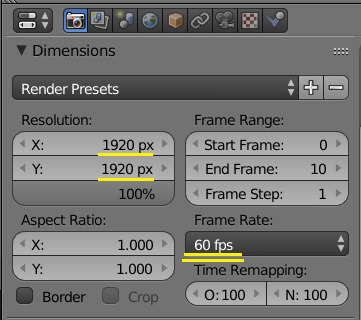
The resolution here will be your resolution per eye. I usually go with 1920 x 1920 for 180-degree video because that’s the max resolution most live-action VR makers use, but you can go even higher if you want. For 180° video you want a square aspect ratio so you can use any other resolution you like but don’t go much lower than 1000 x 1000 or the VR effect will cease to work well.
If you’re planning to make a 360° video instead, your aspect ratio should be 2:1. Simply doubling the X resolution to 3840 will give you close to 8K total resolution (4K per eye), I don’t think many systems can play that well - although we’re starting to see content at that resolution . Personally I think 2000 x 1000 per eye is a reasonable resolution for 360, but you won’t have the same visual sharpness as in a 180 ° video of course, so consider carefully whether the experience you want to deliver needs a 360 ° field of view.
Very Important: Set the frame rate to 60 fps. Do this right from the start of your project if able. Although I think the PSVR can’t play more than 30fps, 60fps is a must for comfortable VR viewing on other platforms. And it’s much easier to resample down to 30fps later than it is to go the other way around.
If you’re working with an existing scene that’s been animated at a different frame rate, you can use time remapping - however if you’ve got any particle effects or fluid sims in the scene, they will be irrevocably broken - no easy way around that. It’s also very buggy if you want to make changes to your animation with time remapping activated.
For example for a scene that’s originally 24fps, change the FPS to 60, then under time remapping, set O:24, N:60. Then you need to change your start and end frames: Just take the original frame numbers and multiply them by 2.5 (60/24). You can type the formula directly in the cell.
With that out of the way, let’s activate stereoscopic rendering:
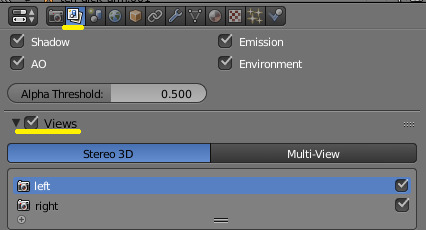
Go to render layers, then tick Views and choose Stereo 3D. You now have a left and right view.
Now select the camera you want to work with, set it as the scene camera and let’s set it up for VR.

First, under Lens / Perspective option change the field of view to 90°. This won’t actually change anything in the final, rendered images, but the camera previews in your viewport will be a lot closer to what you’d actually see in the goggles so it helps a lot when positioning your camera later.

Next, change your lens to Panoramic, this is where all the really important settings are. My own usual settings are pictured above but let’s review them one by one.
Type: Equirectangular is the most widely supported type of view for both 360 and 180 degree videos. Some 180 degree videos use fisheye instead (most SFM videos do) but I prefer equirectangular myself as it makes use of your full video window whereas fisheye leaves the corners dark, so you’ll get slightly sharper images overall for the same video resolution.
Latitude / Longitude: Set latitude to -90 / +90 and longitude to the same for 180-degree video, or to -180/180 for 360 video. Make sure you’ve set up your resolution and aspect ratio accordingly in the previous steps.
Clipping: If you’ve got some stuff moving right under the “nose“ of your camera, it might get clipped through so reduce the start value to 0.1 or even less. In VR you want to be pretty close to the action.
Stereoscopy: There are three modes you can use. Off-axis is what I use almost all the time. With off-axis the two cameras converge along a plane at a set distance in front of them. It’s the default for all 3D applications really
Parallel is good if you’ve got some distant objects where you still wnat to have 3D effect and nothing too close to the camera.
Toe-in is good I think if you’re doing a 360 video and you’ve got stuff happening very close to the camera in all directions. Works somewhat similarly to Off-axis.
Convergence Plane: (Off-axis / Toe-in only) This is how far away the stereo cameras converge. This should almost always be 30x you interocular distance (see below)
Interocular Distance: The default value is the human average: 65mm. You do not need to change that unless your scene and models aren’t scaled to normal human size in Blender. Then you can use this to cheat: if your models are 3x too big, multiply this by 3 too. Artists rarely worry about sizing their models and scene correctly because it has virtually no effect unless you render things in 3D.
I feel like cheating in this way makes some of the resulting scenes look slightly weird, but that might just be me.
Spherical Stereo: This might be useful for 360 videos, but otherwise should be disabled.
Pole Merge: Usually disabled This gradually reduces the eye separation (stereo effect) as you look up and down at extreme angles. You only need to use this if there’s stuff happening directly above / below the camera and you find that the eyes cannot focus on that properly no matter what you do.
Finally, at the very bottom of camera settings, make sure your depth of field is disabled: Aperture set to 0.
2. Setting the scene
Laying out a scene for VR is very different than traditional 2D work. This is hardly an exhaustive list, but here are some common considerations and pitfalls to avoid to make the best out of your VR scenes.
FPS: I’ve said it before but high FPS are hugely important for a good VR experience. Set this to 60 from the get go if possible.
Size Matters: That’s what she said, eh.
It’s a common pitfall to animate a whole scene, spend days rendering it for VR, put the goggles on and only then you figure out that your models are giants and you’re just a tiny ant observing the scene. While this can be fun to play with if you know what you’re doing, it’s disastrous if you don’t.
Right as you start to set up your scene, make sure your models are human-sized. A quick way to do that is to spawn a human metarig and scale them so they’re roughly the same size. Even better, look up how tall your character is supposed to be, and scale her to exactly that.
Models imported from SFM need to be scaled down to 0.027 in Blender. Grab them in Object mode, then hit Shift-C to center your cursor at 0, then [S], [.], [0], [2], [7]. to scale down to the exact value. Finally use Shift-A to apply the scale transform.
I’ve also seen some models that are exactly 3.28 times bigger than they should be. I suspect Imperial units are to blame.
If all else fails and your scene is already set up with the wrong scale, you can cheat and adjust the interocular distance as indicated in the last chapter.

Here I have a scene with a 6-meter tall d.Va. She should be just 1.6 or so, so I’ve multiplied the interocular distance by the size ratio.
Camera Viewport: After you’ve enabled stereoscopy, your camera viewport may change to an ugly red-blue display. To get rid of it press N to bring up the side menu, and under Stereoscopy, choose either the Left or Right eye. You might want to change from time to time to make sure the field of view is unobstructed for both eyes.
You can use the check boxes below to display both cameras, so you’ll see where each “eye” is, and to display the convergence plane described in the last part. The slider is the opacity of the plane.

Positioning the camera: You need to position the camera a lot closer to the action than you’d do with a regular, narrow-angle camera. Both your video resolution and that of the HMD are limited, so if you want the viewer to catch details, you need to be fairly close to them.
If you’ve set the camera FOV to 90° in the previous chapter, your viewport should give you a decent preview of what the scene will look like with the goggles on.

Varren buddy seen through a regular 40° FOV camera.
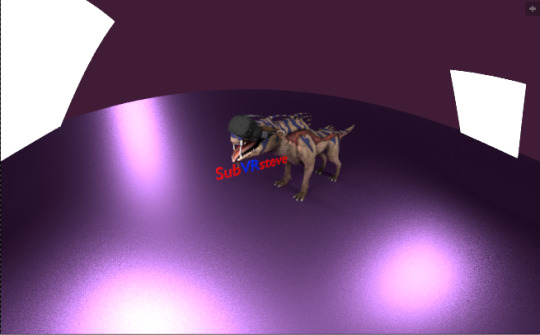
Without moving moving the camera, I’ve changed the FOV to 90°. Not only my buddy looks tiny now, but I’m also seeing some objects that I wasn’t supposed to. I need to rework my lights system.

That’s a bit better. I’ve moved my camera forward to about 1 meter from the Varren’s head. I could get even closer for detail but he just ate a pyjack and I don’t want *that* much detail.
Keep in mind that what you see through the camera viewport is just what the viewer will see when looking straight forward. If he turns his head around, he’ll see more stuff - especially if you’re rendering in 360.
If you get closer than 50cm from any object, the eyes will start to strain a bit to focus on it. You can balance that a bit by moving the camera’s convergence plane closer. Experiment on still renders to see what works.
Experiment with that, if it’s well done moving objects close to the camera so they appear to touch the viewer’s head can be extremely immersive - it just takes a lot of trial and error to get it right.
Movement: It’s safest not to move your VR camera at all to avoid causing motion sickness. Rotation especially should be avoided - the viewer can usually just turn his head around.
However a bit of motion can actually improve the immersion as long as you keep it slow and steady.
If you’re doing a POV scene where the viewer’s head is moving a bit you can use constraints to have the camera follow the head, but not rotate with it.
Keep your camera’s Z rotation at 0 if able. I’ve had problems in the past when the camera was tilted sideways, it made objects impossible to focus on unless I also tilted my head sideways. It might be linked to some other settings, but just zero out the Z rotation to be safe.
Eye contact is one of your best tricks. Try to establish and keep it if your scene lends itself to it. It’s a staple of live-action VR erotica and for good reason. Most blender models have their eyes rigged with a view target. If they don’t you can try and use track to constraints but it’s a bit trickier.

Some cozy time with Ciri (credit: dudefree). Great use of lighting and eye contact there. Realistic movements of her hair and medallion add to the immersion.
Lighting: so, those 20 lights you added in to make sure every piece of your scene was subtly enhanced… great artistic work, but it’s going to kill your render times. Keep your lights setup reasonable. Getting the perfect backlight isn’t quite as important for VR.
Lighting is often used to bring forward the geometry of a scene, and give the illusion of 3D. But here, you’ve got the real thing, or almost! You don’t necessarily need all the subtle shadow plays.
On the other hand, setting the atmosphere is just as important in VR, and clever use of lighting can do just that.
Be very careful with glossy and transparency shaders. They don’t seem to work quite right in VR- the reflections are a bit off between the two eyes and will make it hard for the eyes to focus on the object. Again, experiment and do test renders to see what works.
Preview Runs: Unfortunately, VR will make little details stand out so you may find problems with your scene that you never did before. Clipping issues you’d never have noticed otherwise can become huge, jarring problems. Do plenty of test renders before you commit to rendering the whole animation.
Unfortunately OpenGL doensn’t let you do preview renders for VR, so you’re stuck with Cycles for now. What I usually do before starting the full render of an animation is to do a run at 60-70% resolution, very low sample count and just one frame out of 5. Or sometimes I’ll just render with the final settings but one frame out of 10 or 20. This way I won’t have to re-render that frame when I do the final video.
3. Optimizing
The good news is, this whole section from my previous tutorial is now almost entirely obsolete with Blender 2.79. Yes, that is good news. You can still expect render times in the days or weeks for some videos, but it’s a huge improvement over 2.78. As a consequence I’m cutting out a lot of settings from the old tutorial that don’t really matter so much anymore. Let’s focus on the essentials.
Turn on GPU rendering: If you can and haven’t already, this is a must for rendering moderately fast in Cycyles. This is found under User Preferences / System: Choose CUDA for NVidia GPUs or OpenCL for AMD cards. The good news in 2.79 is that the once terrible OpenCL support has been improved to the point where the newest AMD cards actually outperform their Nvidia peers by a large margin. Quite the reversal.

Select CUDA or OpenCL under User Preferences > System. Save User Settings

Go back to render settings and make sure GPU compute is enabled.
Denoising: That’s the big new feature of 2.79. It’ll smooth out all the fireflies and dark spots that used to mar cycles renders in older versions. I’m no expert on image quality but it looks to me like the loss of detail is minimal. That means we can now afford to render scenes at much lower sample count and still have them free of noise.

To enable denoising, go to render layers and tick the corresponding box. Default settings have worked fine for me so far. If you have more than one render layer, apply it at least to your main layer.
Render settings: This part requires a lot less trial and error with denoising on. These days I render almost all scenes with 100 samples and default values for the other parameters. You can increase the sample count if you’ve got some very complex plays of light going on, but otherwise 100 samples will give you good detail and no noise.

Un-check square samples or your 100 samples will instead become 10 000.
4. Rendering
The last thing you want to set up before rendering is the output. You want to output as an image sequence absolutely. It takes me 5-6 minutes to render a frame, so at 60 fps even a short clip is likely going to take you days, so you want to be able to interrupt it and resume it when you want to.

Still on the render panel, choose JPEG or PNG with minimal compression.
Un-check overwrite: this way if you’ve already rendered some frames, it won’t re-render those - this way you can resume an aborted render.
Then, pick Stereo 3D (both images in one file). 180 degree videos are usually laid out side-by-side, while 360 are top-bottom. Either will work on most players, it’s just a matter of convention.
That’s all the settings done, now you can it that big Alt-F12 button as you’ve been itching to for the last hour, right? right?

SAVE your scene first! You’re about to start rendering for a loong time and a lot can go wrong. Imagine rendering half a scene in a couple days, then your computer crashes - so you reopen the file and resume rendering, except you didn’t save your latest changes so you’ve rendered half of the video with different settings. Happened to me.
Ok. NOW you can go for it. See you in several days.
5. Encoding
Barring any disasters during the render process, you should now have a few hundred rendered stereo images. You can already load those up into a VR viewer and check them out one by one. You have several options to finish up the process. Again the cool thing about Blender is you can do all that in Blender’s own video sequencer. Add a sound-track, a few effects even, overlay a logo - Blender can do all that and much more.
However I don’t use Blender anymore myself for encoding as I found I other solutions can give you better encoding quality, control, and access to more formats. A few of your options are:
Output from Blender in uncompressed AVI then use Handbrake to re-encode in the format of your choice.
Load up the image sequence in VirtualDub and encode from there.
Use some pro / enthusiast video editing solution such as Premiere.
In any case the questions you need to ask yourself are going to be the same. What formats to output to so that my videos are viewable on a maximum of platforms?
Now I do my high quality encodes at eiher 4000x2000 or 3840x1920 (1920x1920 per eye), 60 fps. The latter is the resolution most live-action VR erotica makers release at. I encode using H264 coded, 2-pass encoding, min bitrate 30000, max 40000 and maximum render quality settings turned on. That will work fine on Vive, Oculus, GearVR and other high-end HMDs. Finally the video is saved in MP4 format, with AAC audio.
I then do another render at 2160x1080p, 60fps, as that is the maximum resolution iPhones can play, and works well enough for most other platforms. This is also encoded in H264, 10k bitrate.
From what I’ve read, PSVR should be able to play as high as 3200 x 1600 resolution, so it could be worth it to do an encode run at that size too.
I usually loop short animations several times at this point because many VR video players don’t handle looping well.
6. Viewing
Nothing to do with Blender at this point, but it bears repeating. Lock the door before viewing VR erotica. You’ll be entirely unaware of your surroundings for an extended period. Viewing regular porn, someone can walk in and catch you at an awkward moment. Viewing VR, someone can walk in, film you and post it on your own Facebook before you’re aware of anything. Hm, not that this has ever happened to me.
If you’re new to this, Virtualrealporn has a pretty comprehensive guide on how to watch VR movies on every existing platform.
Personally I use Simple VR Player on my HTC Vive, a paid app but well worth the money. Otherwise the free version of Whirligig will do the job, but the UI is a mess.
I also use a no-name VR headset for smartphones I got for free from a phone shop promo. It makes for a surprisingly comfortable (and wire-free) experience. Of all the VR players available, the three that seem to do the job best for me are AAA VR Cinema, VaR’s VR Player, and VR Player Free. Neither is perfect but they get the job done and play smoothly.
That’s all! Major props to Likkezg for sharing some of his Blender wizardry with me, and to everyone else who came to me with feedback on my work, I’ve been learning something new every day thanks to you guys.
39 notes
·
View notes
Text
Making Soldier 76′s Gloves: A Tutorial

Yay gloves! This is a walk-through that shows how I made them. I did make several mistakes along the way, but hopefully there is still value to be found in the process. Enjoy!
Warning: Ridiculously image heavy!!
As usual, I started by hoarding references. The 3D model I downloaded was very helpful for this.

Several months ago at the beginning of this adventure, I sat down and planned how all the costume components would be built. At the time I intended to use spray adhesive to tack down some type of stretchy, plastic-y fabric--probably vinyl. Later I learned that my library’s makerspace had a die cutter, so “stretch vinyl” was replaced with heat transfer vinyl. I did choose to omit the grey palm, but otherwise these are accurate to the game model.

The pre-existing gloves were a pair of these from Costco. In hind sight, they weren’t 100% ideal; see that seam across the knuckles? It’s going to cause trouble later.

Next I needed to make a digital cut file for the Silhouette die cutter. Die cutters are basically digital cutting machines... sort of like printing with a knife. You give them a file with lines, and a knife (or other tool) traces them onto materials like paper, fabric, and vinyl. The software requires vectors to cut, so I used Adobe Illustrator. If you don’t have access to this software, the open source equivalent Inkscape would work just as well. I began by very carefully measuring the gloves to make a janky but correctly scaled pattern. The red armor was drawn over the top.
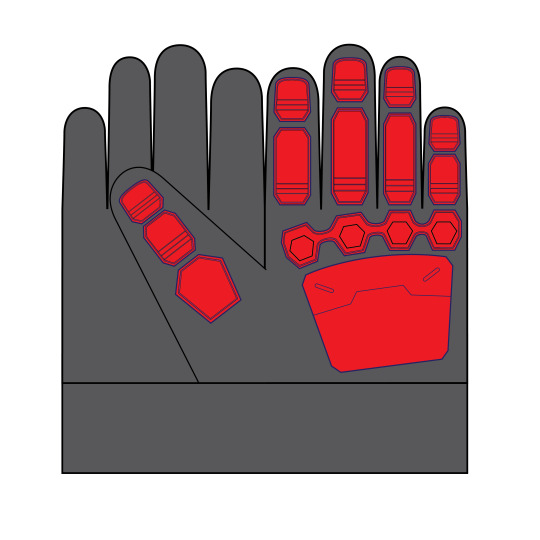
Next, the templates were printed and laid over the glove to check for scale. as you can see, the guard on top of the hand is much too large. I made a few adjustments to the paper templates, scanned them, and modified the vectors to fit.

Then it was cutting time! Only the finger and knuckle guard bases were made from heat transfer vinyl. (If I didn’t have access to the die cutter, I would have traced the templates onto masking tape and used them as a mask for fabric paint.)

Next I wanted to make the knuckle guards. These could have easily been made with Sculpey, but I sit next to a 3D printer all day at work so I took the easy way out.
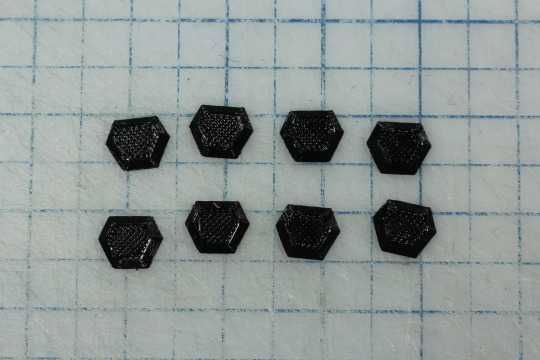
As normal with 3D prints, these had a distinct texture. I decided to take the opportunity and try out Automotive Filler Primer since it’s supposed to be the bee’s knees for smoothing 3D prints. Sanding PLA sucks, so I’ll jump on any possible opportunity to avoid it. In preparation for spray painting, the knuckle guards were stuck on a piece of cardboard with hot glue. A little clearance from the surface means their edges will be more clean, plus I don’t need to keep track of 8 tiny pieces of plastic. The hot glue will peel off cleanly later.
From what I had heard, you don’t need to sand filler primer because it self-levels. After one coat, I was not so sure.

Three coats in and the ridges were actually more pronounced, so I broke out the sandpaper.
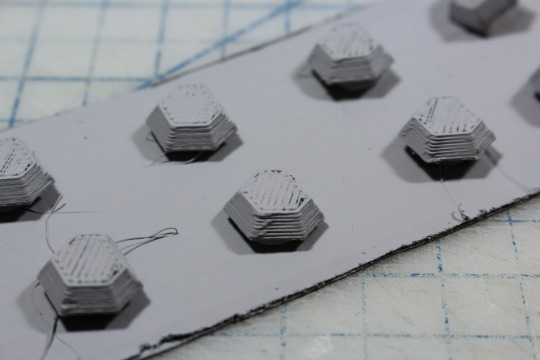
Amazing!!! It looks awful but dang did it feel smooth and it sanded SO MUCH EASIER than PLA! 220 grit paper was plenty remove material.

After two more passes of spraying and sanding, the guards were looking pretty smooth. Here they are after their final spray:
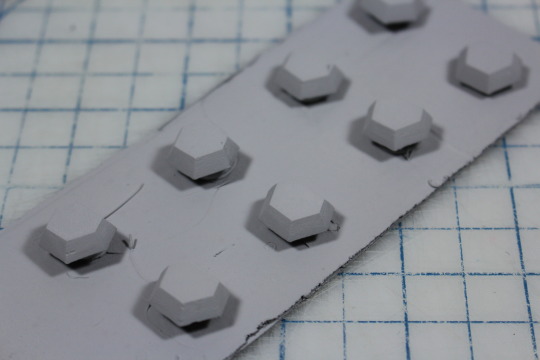
Fun fact, that stuff will clog up your paper something fierce! Buy a lot of sandpaper if you have large things to surface.
Next up was painting. Normally I would spray paint or airbrush something like this, but the weather has not been cooperating lately so I hand-painted them instead.
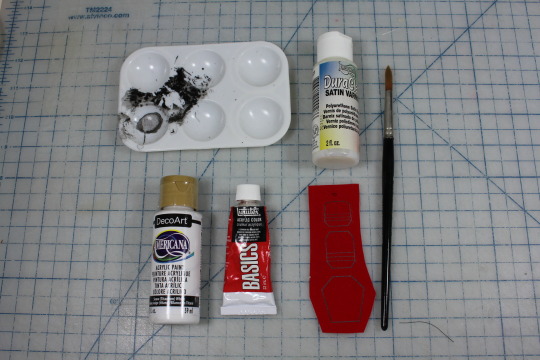
Since the red paint is somewhat translucent, I gave the parts a thin coating of white first. Then red was layered on until I achieved full coverage.
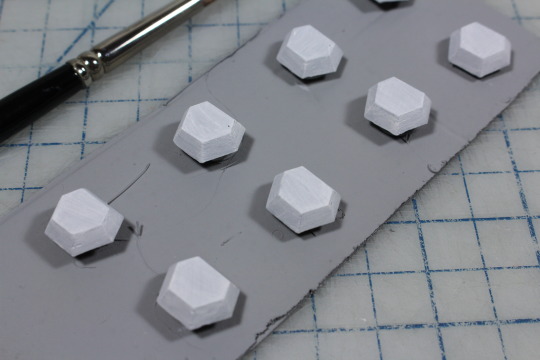
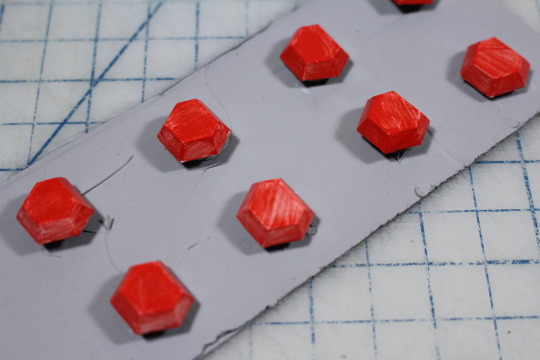

The final detail for the knuckle guards was a thin, black line running around their base. Any permanent marker will do.

The knuckle guards still need weathering, but I prefer to weather everything at once so I moved on to building the hand guards. Using the paper template from Illustrator, I traced the main shape onto 6mm foam. You will notice some indents running along the flat surface:
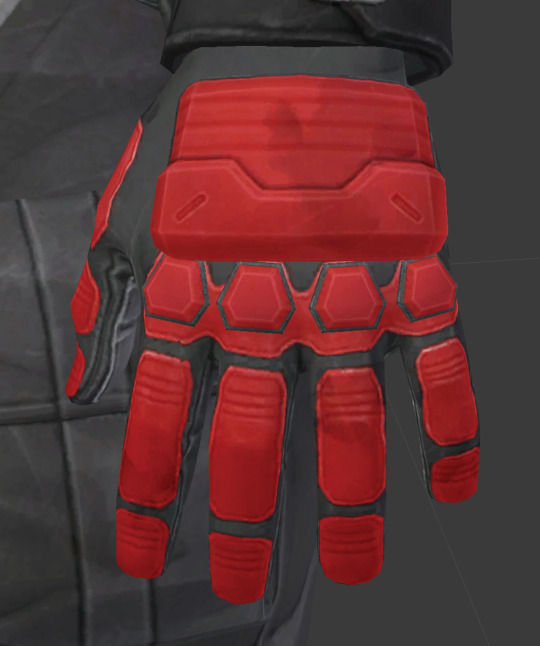
Those were recreated by scoring the foam with an X-acto knife. When blasted with a heat gun, the foam will contract slightly to create a groove (pictures of this later).
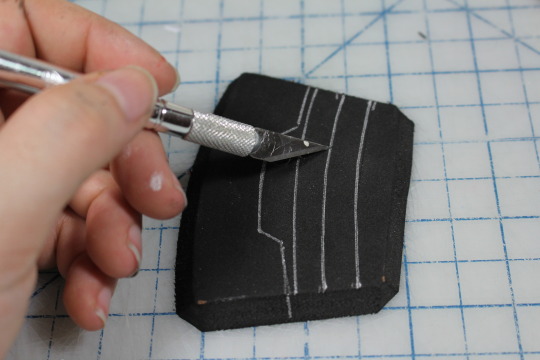
I added a second layer to the guards with 2mm craft foam.

In order to emphasize the angles, I carved a teeny grove with my pen knife and removed the excess material with a pair of tweezers.


This channel helps the foam bend a little sharper. It might seem subtle, but the effect was worth it.

Next, I used a sharpened aluminum tube to punch perfect circles into the foam. You can find these at most hobby stores and sharpen them with a needle file--also to be found at most hobby stores. The holes were expanded into slots using my handy X-acto. This was surprisingly hard to do neatly; I wish EVA foam was a little more dense :/
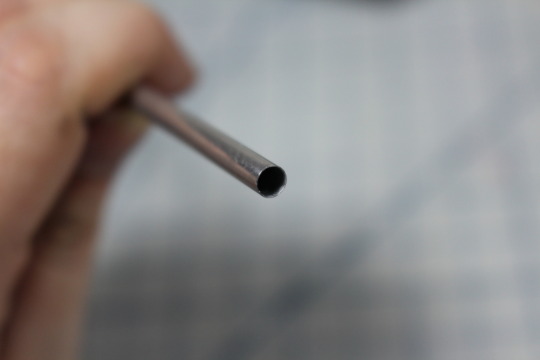
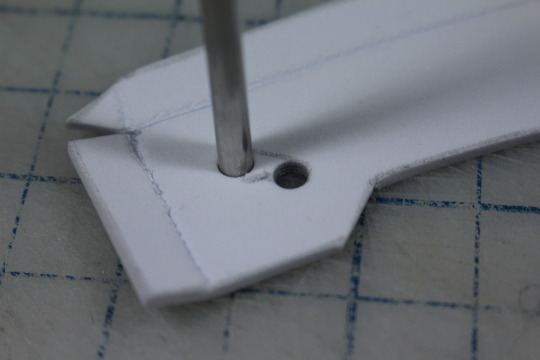
The parts were adhered together with contact cement. I had to do this outside and it was dark, so I don’t have good pictures :( As a last step before painting, I used a heat gun to give them a gentle curve and emphasize those grooves. Unfortunately, I was a little liberal with the heat and you can see some low-key melting. Oops. Given the size of these parts, it was an interesting challenge to attempt without gloves.
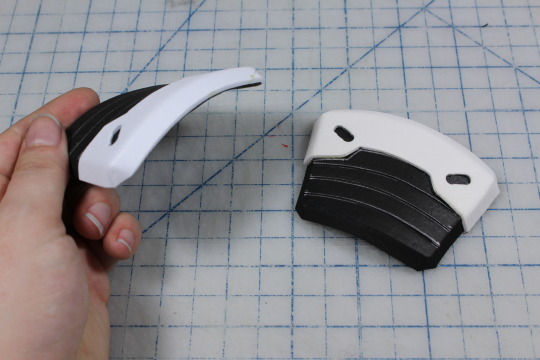
For painting, I decided to use my airbrush. I was gifted a setup yeeeeeeeears ago and I hardly ever use it. Time to change that! I primed the foam with this all-purpose primer which claimed to be slightly flexible. This is a lie. Don’t buy this brand of primer if you need something to be flexible!!

Like the knuckle guards, I gave the hand guards a light pass with white so it would take less red to reach full coverage. Full disclosure, I kind of suck with air-brushes. See that weirdo blob on the left corner of the left guard? That’s what happens when you spray too much paint with an air-brush. They also had a funky texture which I believe was a result of too much paint at once.
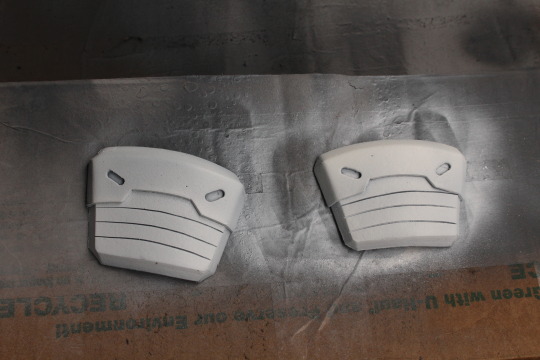
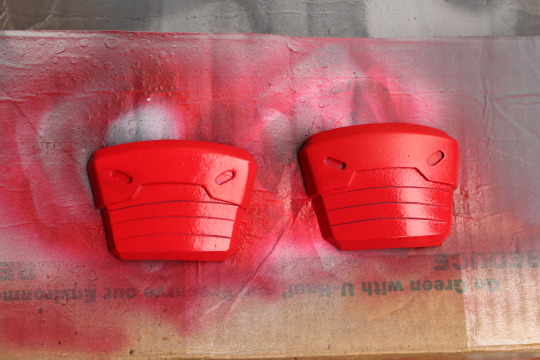
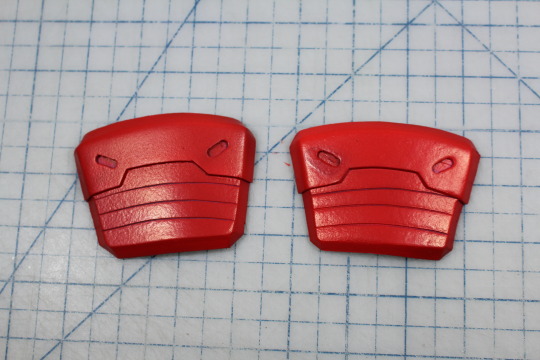
For weathering, I used 400 grit sandpaper to remove paint from corners and edges revealing the primer beneath. I think it gives a pretty neat effect! Grime was a mixture of Mars Black, Burnt Umber, and water. Finally, a coat of brush-on varnish sealed the paint job.


It was only after applying the varnish that I realized it was glossy, so I misted the parts with Matte Fixative meant for sealing drawings. This is not ideal and you should be smarter than me and buy the right varnish to begin with.
Finally, it was time to add the finger pieces and assemble the gloves! This was done with an ancient (circa 1970′s) iron, a scrap of muslin, some cardboard, and sewing pins.
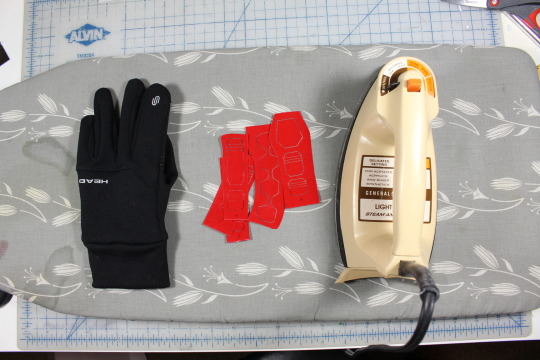
Note about the vinyl: There is such a thing as stretchy heat transfer vinyl. I didn’t know this when purchasing, but stretchy would definitely have been preferable. The fingers of a glove are constantly flexing and moving, so over time my regular vinyl will break down. I did verify that my pattern would stretch, but you should still purchase the proper variety if you choose to do something like this. Thankfully the pattern I cut allowed the material to stretch somewhat.

Once cut, the vinyl needed weeding. Weeding is the process of removing everything you don’t need from the piece to be transferred. While there are specific tools available for this task, I like using an X-acto knife. After you get a piece started, tweezers can help remove the rest. Be very careful during this step; sometimes the machine doesn’t quite slice all the way through and you can pull off the wrong parts.
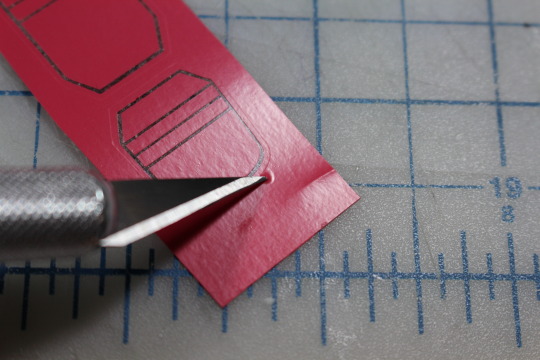
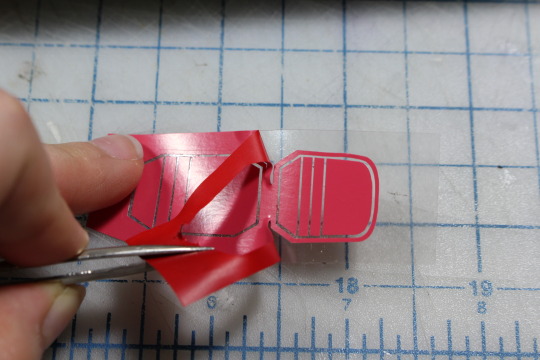
With the parts weeded, it was time to iron them in place. Heat transfer vinyl needs to be pressed while perfectly flat. The fingers of these gloves have gussets on each side which equals a lot of fabric and seams in a small area. Such construction makes them form-fitting and comfortable, but I couldn't get them to lay flat. To remedy this I made an insertable cardboard finger and pinned the fabric in place. It was important NOT to stretch the fabric while doing so or else the vinyl would crumple when un-pinned.



With the fabric secured, I attempted to stick the vinyl in place using the mildly adhesive cover plastic. Alas, it just wouldn’t stay, so I used a snugly pinned piece of muslin to hold it down. 15 seconds of pressing with the iron, and ta-dah! Red decals :)
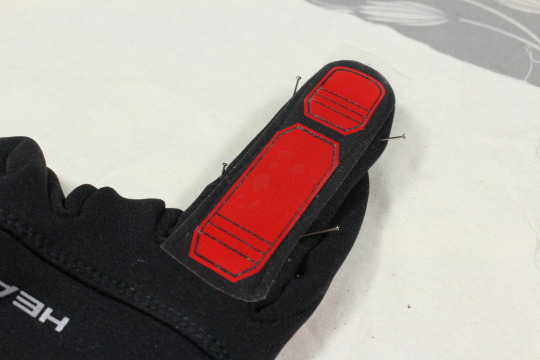



These gloves are two sizes too big for me in case you couldn’t tell :)
Remember how I mentioned that seam across the back causing trouble? Unfortunately it runs right through the middle of a decal. It was very tricky to iron without burning the vinyl and it’s kind of ugly. 10-foot rule will save me, but it could have been avoided by buying better gloves.

The last step was gluing the hand and knuckle guards in place. Because the fabric is stretchy but my parts are curved, I needed to put the gloves on Casey before gluing down anything rigid. Alas, I don’t have many images here because Casey didn’t feel like being a hand model and we were outside because of glue fumes. Each hand guard got a thorough application of E6000 in the center with hot glue around the edges. I wanted the strength of E6000 but needed the quick dry time of hot glue, so this worked fairly well. Overflowed hotglue was colored with a Sharpie and disappears from a distance.



More E6000 was used to fix the knuckle guards. Then the gloves were tossed into the Bin of Shame ™ to cure without fumigating my room.
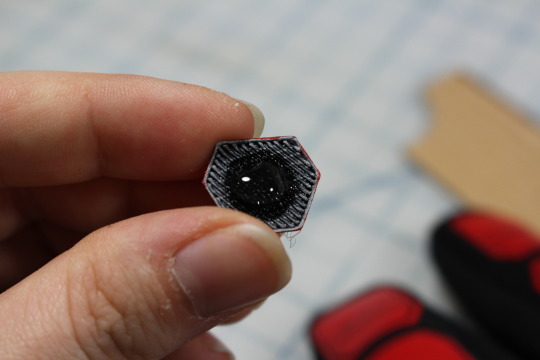

After two days of curing, everything was finished! I'm really happy with how they turned out :D

98 notes
·
View notes
Text
First sprint of video done [still need focus group stuff + learning to move pre comp]
So far I had given a lot of information about helping the climate from home so I wanted my last point to benefit both the climate and the person, this is why I kept the point on oxygenating plants until last. I drew these within illustrator and rather than exporting them as individual png’s as I had done previously, I was a little smarter this time. I moved each layer so that everything existed as its own layer, not paths under one overarching layer, as Illustrator would usually produce layers. By sorting them in this way it allowed me to import the illustrator file to After Effects and select it as composition. The result of this was instead of having one png image, I retained all of the data of my layers which would let me edit them individually within after effects. So I could animate individual plants without affecting one another. This was necessary as I wanted to make the leaves of the plants sway as the windows are open, but as they overlap the window, I could not have done this if it was all one png.

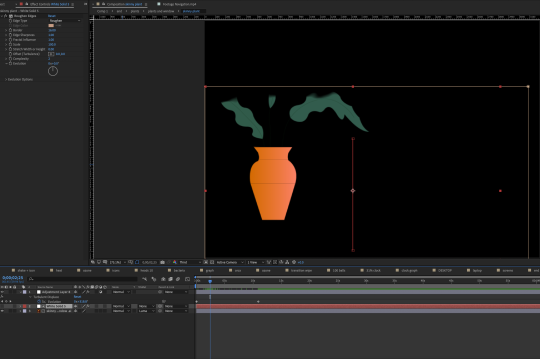
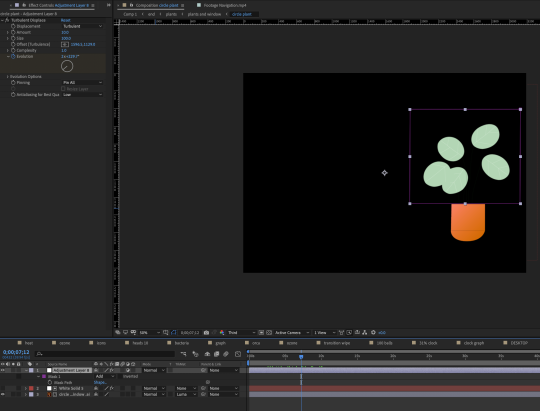
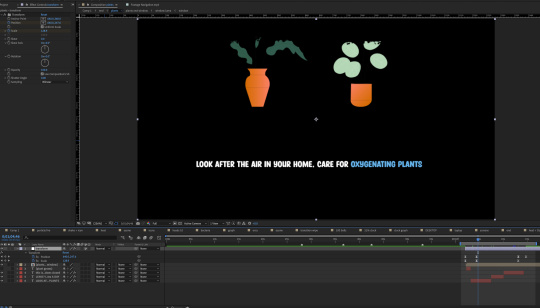
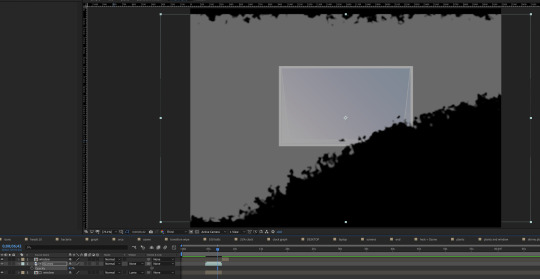
I won't bore you by explaining the process once again but I used the same luma matte, white solid process to reveal the plants as I have prior in this video, with the roughen edges effect applied, as well as a feathered mask at the top to make the reveal less blocky and more like a shadow lifting. I copied this white solid over to the pre comp of my more circular plant and fixed the position keyframes, giving me a quick transition for both. For the window pane I did something a little different. I have an assets folder full of fair use luma mattes I have both collected and made, so I imported one where the white space is moving down diagonally right, I chose this as I wanted the window to have a slightly more dynamic reveal to the plants. I set this as a transition I placed this luma matte mp4 over my window pre comp, and set the pre comp to ‘luma matte [luma matte 02.mov]’. I followed this process with the transition between backgrounds in my main composition. As I wanted this final shot to feel like the inside of a home I went for a more beige, warm colour for my background. To transition to this from the green prior I used a luma matte using four roughened circles.
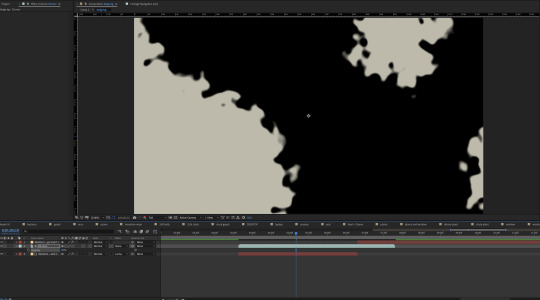


Once I had all of this in the right place I went to animate the sway of the leaves. As I mentioned composing my layers correctly in illustrator really sped up this process for me. Now all I had to do was make a new adjustment layer and apply ‘turbulent displace’ which I would use for the sway. This effect is quite powerful so I dialled down the amount and frequency of the displacement a lot, then keyframed the evolution to create movement without changing the scale of the effect. To apply this to my other plant all I had to do was copy the adjustment layer into its own pre composition. I applied a square mask to both adjustment layers so that the effect only took place on top of the leaves and did not effect the bowls housing them.

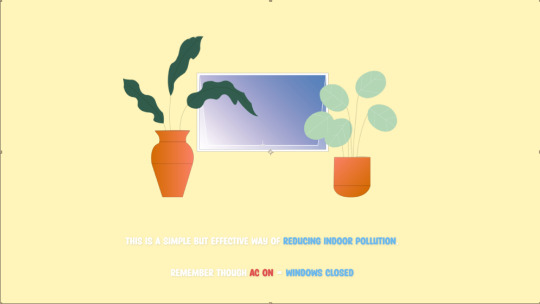
I used the transform effect on an adjustment layer in this composition to start off zoomed in on the text, with the effect slowly zooming out and the position returning to the centre slowly throughout the duration of this final clip. I found initially that I was getting distracted by the growth and swaying of the plants rather than reading the information. So by using the transform effect I tried to orchestrate the view of the audience and create a forced perspective toward the text which I think was quite successful. (2 images above)
This for now marks the end of the video, after it I just put a couple of pieces of text that I hope after watching the video makes people feel inspired. From this point my plan is to render out what I have to get some feedback from a range of people. Hopefully the feedback will highlight any areas that need improvement and I can make amendments to anything that becomes apparent. I am really happy with where it is so far though and I can see it working both as one extended video on YouTube as well as smaller bitesized content on Instagram. So it will be good to hear what people think and to move forward from there.
youtube
0 notes